July 2024 News
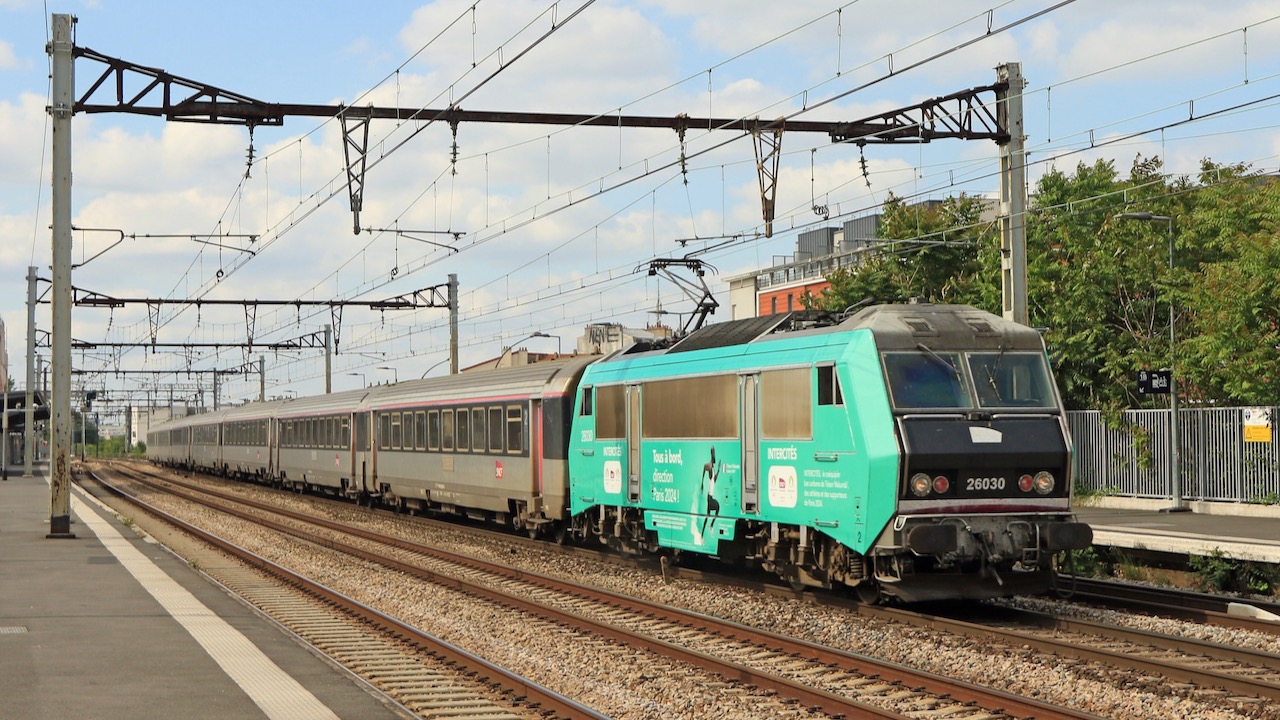
Jeux Olympiques d'été de 2024
The 2026 Olympics will take place between 26th July and 11th August in Paris and 16 other French cities as far apart as Lille and Marseille, making transport a key element. To minimise the risk of travel disruption staff have been offered additional pay. Three of the four main railway unions have agreed the pay package offered for working during the Games period. Some 50,000 staff will be eligible for a daily bonus of €95 with a maximum of €1,900 payable. An extra €50 per day is available towards the cost of childcare, and eight days’ holiday may be deferred for up to a year. CGT Cheminots has not signed up.
As the main domestic carrier SNCF has given Intercités BB 26030 a special Olympic livery, seen above passing through Vitry-sur-Seine on Saturday 8th June heading Train 3665 17.21 Paris Austerlitz – Cahors. During the Games, SNCB will increase capacity between Brussels and Paris with additional locomotive-hauled services. On 4th June SNCB locomotives were seen at Gare du Nord for the first time in 27 years when HLE 1870 arrived with a test train from Brussels. The return (EC 73) is seen waiting to depart behind HLE 1862. Both photos: Christophe Masse.
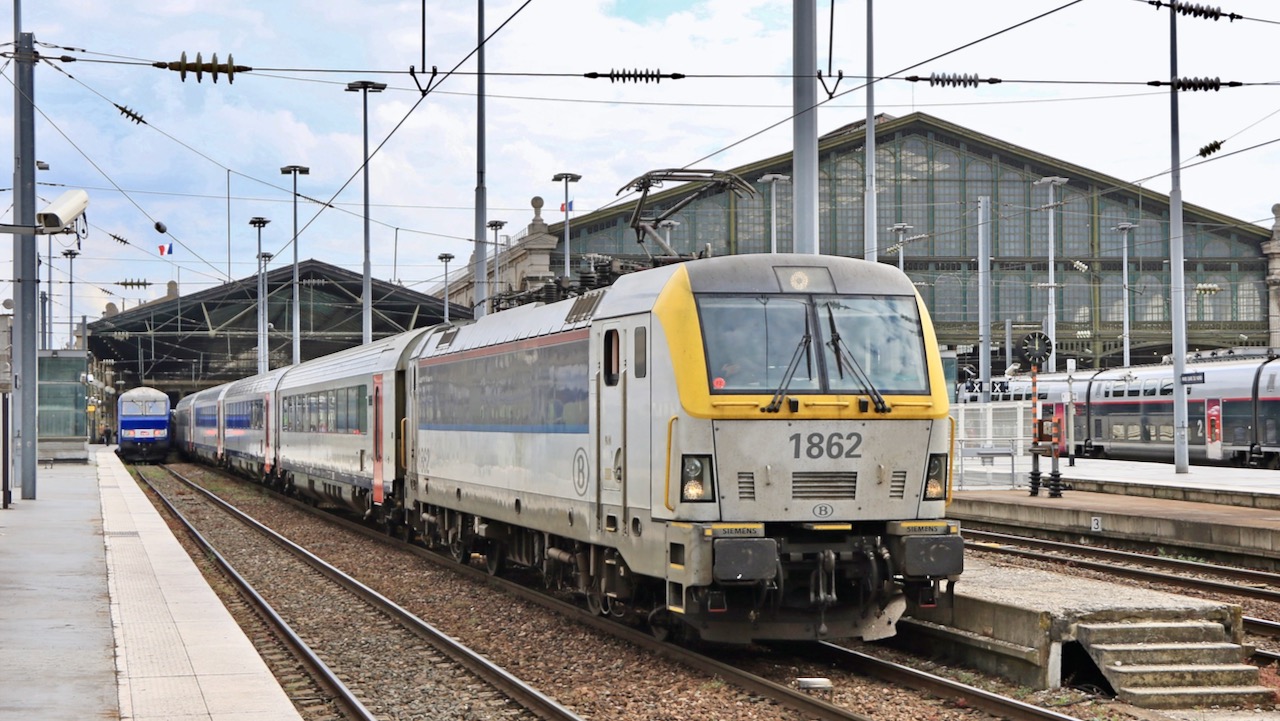
At Saint-Denis four years’ work was completed with inauguration on 15th May of the vast forecourt which now provides gently-sloping access to a 70m passageway from which lifts and escalators rise to the eight platforms. As well as the usual accessibility features, special attention has been paid to the needs of visually and aurally impaired people. Close by, the following day saw opening of a 300m-long bridge linking Landy-France and Pleyel quartiers across 48 tracks and connecting the new Saint-Denis-Pleyel Line 14 metro station with Saint-Denis Stade de France on RER Line D. The bridge links the Olympic Village in the west with the Stade de France and Olympic watersports centre in the east.Photo: ©SPL Plaine Commune Développement/Franck Badaire.
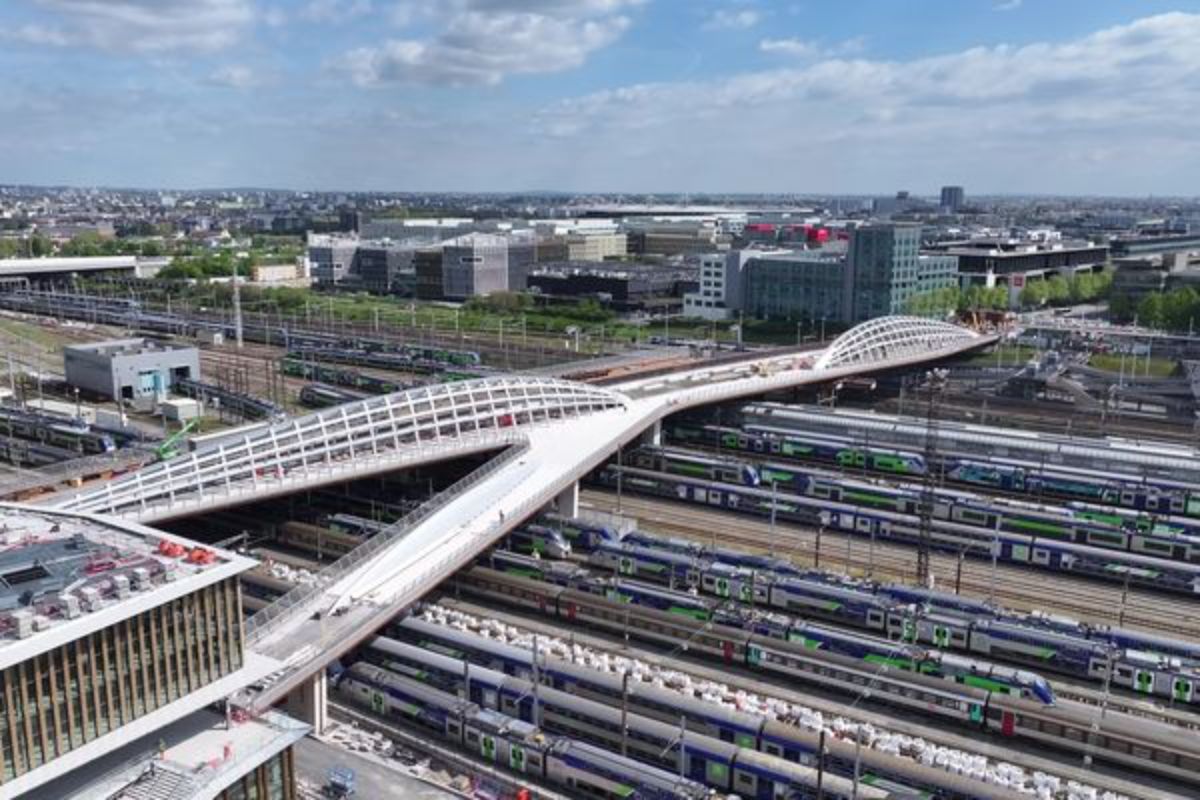
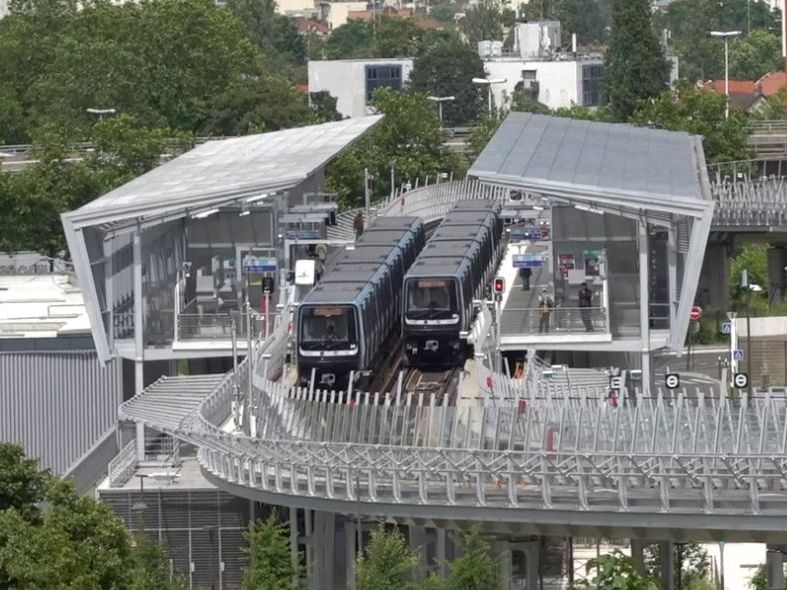
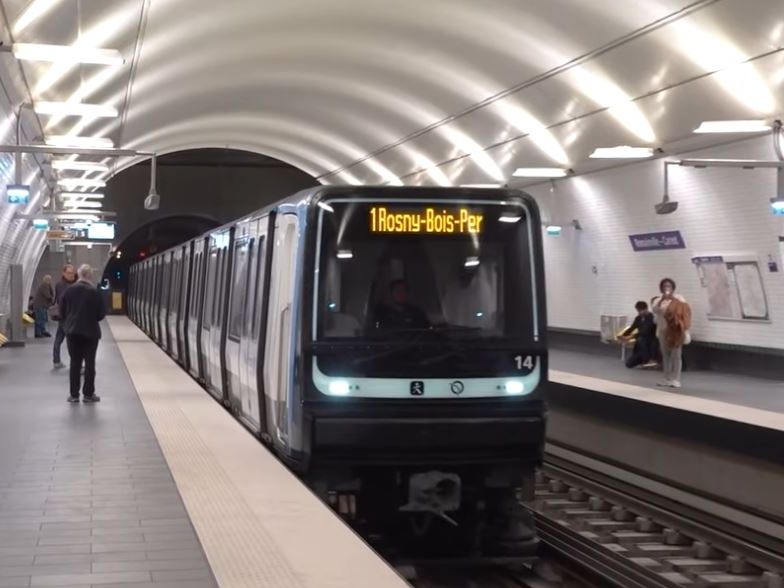
Metro Line 11 was extended from Mairie-des-Lilas to an interchange with RER Line E Rosny-Bois-Perrier (see February News) on 13th June, closely followed by the long-awaited Line 14 extensions to Saint-Denis-Playel and Aéroport d’Orly on the 24th (see April News). Both are destined to play a major part in moving passengers during the Olympics. The 5.4km Line 11 extension has halved journey times to central Paris from parts of Seine-Saint-Denis, with Rosny-Bois-Perrier to Châtelet taking 25min on Line 11 against 50min previously. There are six new stations including Côteaux-Beauclair (left) sited on the 580m viaduct section near the end of the line, and Romainville-Carnot (right). Photos: ©ErebosSan.
The new station at Orly was officially opened at a ceremony on the 19th while trial running was still going on. Huge crowds are expected for the Olympics opening ceremony on 26th July, with 320,000 spectators lining the banks of the Seine. Those with places on the higher stands, around 220,000, have designated metro or RER stations shown on their tickets so as to ease their distribution along the riverside between Austerlitz and Charles-de-Gaulle-Étoile. They must take their places between 15.30 and 18.30. The 26th is also the major mid-summer holiday changeover day, with main line trains likely to be exceptionally busy with holidaymakers as well as Olympics spectators. There will be limited access to stations closest to the Seine, Gares de Lyon, Bercy and Austerlitz, where departures will be closely monitored to avoid congestion. No TGV or Intercités tickets will be sold after 16.00.
Thereafter, the transport network will be handling exceptional crowds throughout the Games until the Paralympics concludes on 8th September. ‘It’s a absolutely colossal job’ said Île-de-France Mobilités president Valérie Pécresse at the Line 11 opening. ‘Contrary to the birds of ill-omen, we are ready. The plan is in place and we have 125 back-up options in the event of unforeseen circumstances’.
The extended Line 14, backbone of the Grand Paris Express network, was opened by President Macron on 24th June, accompanied by former president Nicolas Sarkozy who had inaugurated the GPE project during his time in office.
Doubled in length to 28km, the line has seven new stations plus one more opening in December. Alstom has delivered 54 of the planned fleet of 72 MP14 trains. The special fare for air travellers to and from Orly is €11.50 (compare: Underground to Heathrow £6.70, Heathrow Express £25).
Photo: RATP.
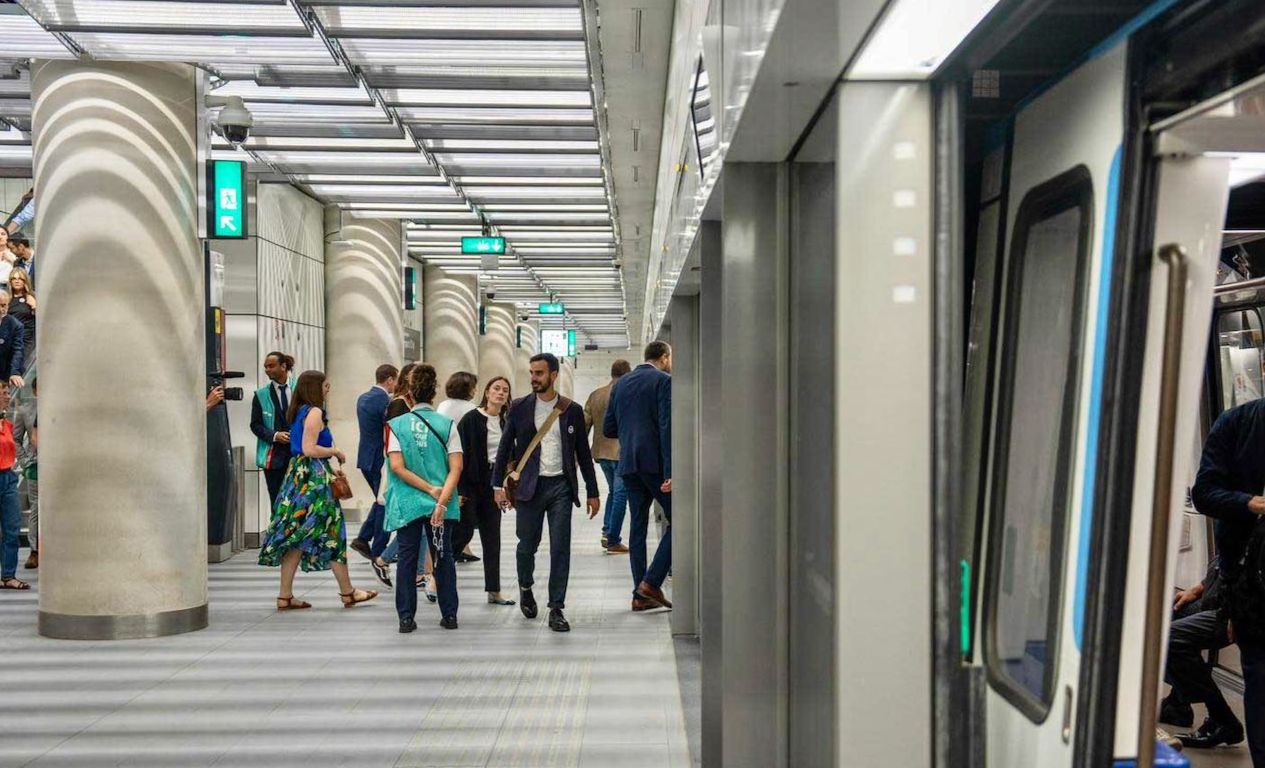
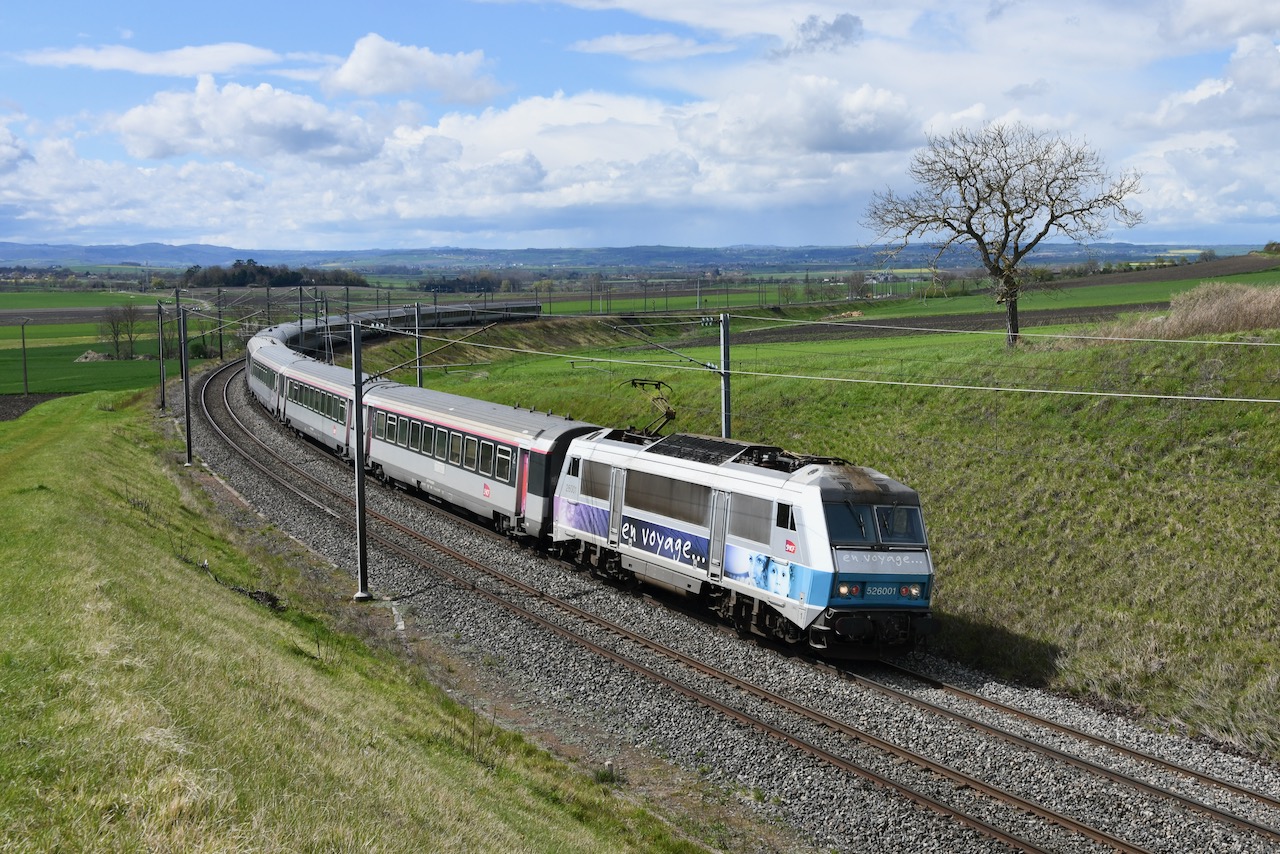
BB 26001 is the only member of the class still bearing 'En Voyage' livery. It is seen above on 1st April passing Randan en route from Clermont-Ferrand to Paris Bercy. While Italian customers may be enjoying TGV M travel by 2026, those on the Paris to Clermont-Ferrand and Toulouse routes are likely to be travelling in Corail stock until 2028, due to delayed delivery of the new CAF Oxygène trains. Photo: Didier Delattre.
SNCF to enter Italian domestic market
On 12th June SNCF Voyageurs announced plans to start Italian domestic high-speed services in 2026, with the objective of capturing 15% of the market by 2030. At present Trenitalia holds two-thirds of the market with the other third taken by Italo, part of Italian-Swiss shipowner MSC. The services will be operated by SNCF Voyages Italia (SVI), which currently operates the cross-border trains between Paris, Turin and Milan.
SNCF is proposing to operate nine each way services a day between Turin, Milan, Rome and Naples, and four between Turin and Venice. Trains will also serve cities en route such as Brescia, Verona, Padua, Bologna and Florence. Introduction will be progressive, as it has been in Spain, where SNCF now holds 20% of the market due to the popularity of its Ouigo low-cost services. SNCF plans to deploy 15 of the new TGV Ms in Italy; currently 115 are on order from Alstom with the first expected to enter service in 2025. The move is likely to be controversial given the continued use of ancient loco-hauled Corail stock on the Paris – Limoges – Toulouse and Paris – Clermont-Ferrand routes and delayed delivery of CAF’s Oxygène trainsets (see June News).
SNCF is negotiating paths with Italian network manager RFI, and is seeking a 15-year Framework agreement. Italy has the lowest track access charges in Europe, compared to France, which has the highest.
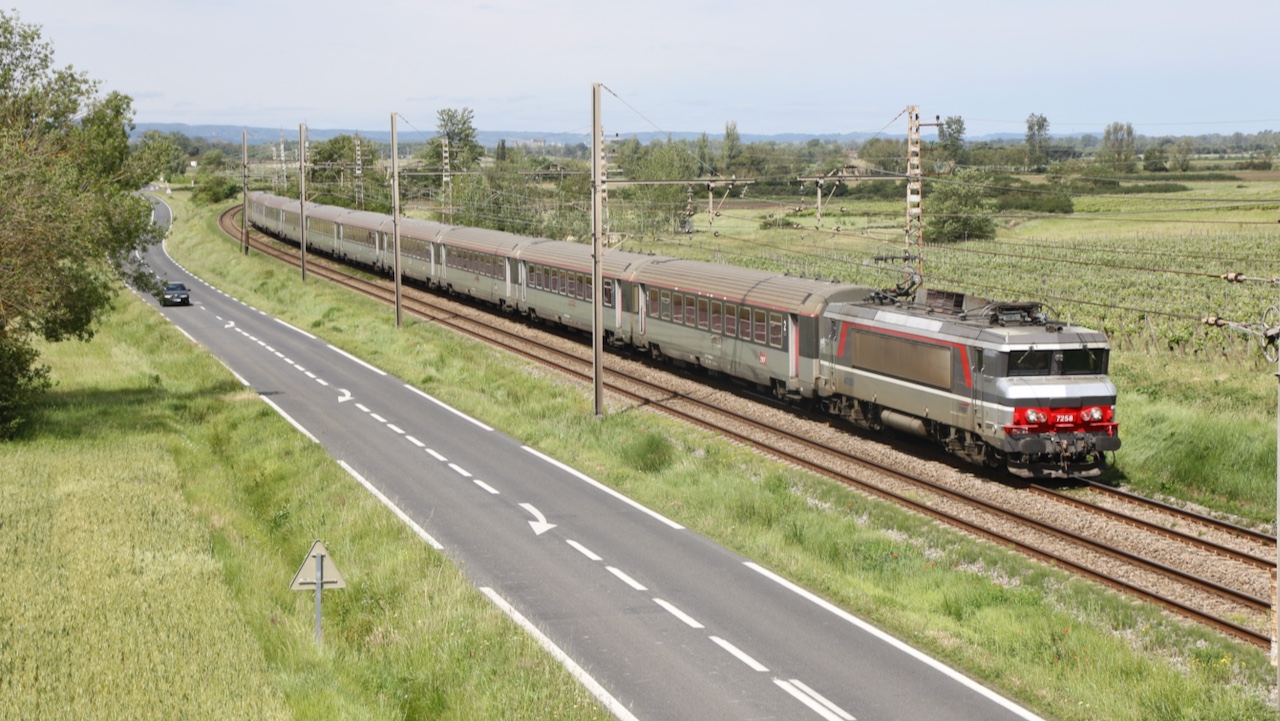
On the 17th May BB 7258 is seen between Carcassonne and Bram with Intercités 4756 Bordeaux-Saint-Jean – Marseille-Saint-Charles. This is the last BB 7200 in service carrying the red and grey Corail+ livery. Photo: Georges Turpin.
New start-ups: Midnight Trains calls it a day – Welcome Proxima
The demise of Railcoop and Midnight Trains brings to three the number of start-up companies which have failed to break into the domestic open-access passenger market in France. Flix, which runs a wide network of rail services across Germany (and coach services across Europe), abandoned plans to develop services in France, describing conditions as unsuitable for its business model. While Railcoop demonstrated that it was possible for a small start-up company to break into freight haulage, the passenger market is far more difficult. Commentators have stated that while the rail market is legally open it is only to existing legacy players.
Whether by coincidence or design SNCF appears to have developed an effective strategy to discourage start-up companies. Cannibalising, scrapping or refurbishing older trains ensures there is no secondhand rolling stock available. The range of services provided by the TGV Inoui, low-cost TGV Ouigo and expanding Ouigo Classique networks leave few openings for newcomers to the domestic market. Even proposals which would barely impinge on SNCF’s business, such as European Sleeper’s Barcelona – Amsterdam night train, have been frustrated by pathing difficulties, regulatory pitfalls and threats of last-minute imposition of engineering works.
This now leaves three potential start-up contenders. As reported in April News, Kevin Speed has appointed professional advisors to help it raise €1.2 billion for 20 new TGVs from Alstom. Le Train, which plans to introduce high-speed services on France's Atlantic coastal routes, announced in spring 2023 that it had selected Talgo to build and maintain its rolling stock fleet, but over a year later it has yet to raise the finance to place a firm order.
Enter Proxima
The one new entrant, which appears to have broken through the funding issue, is the newest. Proxima, which revealed its plans on 6th June, it has been set up by former SNCF Voyageurs CEO Rachel Picard, who was involved with development of the Ouigo brand, and Timothy Jackson, founder of leasing company Alpha Trains and former RATP Dev CEO for Great Britain & Ireland. Proxima has secured €1.2 billion from Antin Partners, an infrastructure investor, enabling it to enter ‘exclusive negotiations’ with Alstom for supply and maintenance of 12 Avelia Horizon TGVs and provide sufficient working capital to kick-start the operation. Agreement has also been reached with Sud Europe Atlantique LGV concessionaire Lisea for use of the depot to be built at Marcheprime (see November 2023 News), south of Bordeaux.
Proxima plans to ‘reinvent the rail experience’ on services westwards from Paris to Nantes, Rennes, Angers and Bordeaux, covering to some extent part of Le Train's proposed territory. Delivery of the trainsets is planned for 2027, although this would be dependant on Alstom which is currently struggling to keep up with demand.
Following the Proxima announcement a further expansion of Ouigo services, with new destinations and more trains, was announced by SNCF on 14th June. From December 2025, Ouigo will run beyond Bordeaux to serve Dax, Bayonne, Biarritz, Saint Jean-de-Luz and Hendaye. This is in response to heavy demand on the Atlantic coast route as well as preparing SNCF for competition from Proxima. Together with a proposed new route to Lille, by 2027 Ouigo expects to be serving a further 15 destinations, bringing the total to 75.
In 2025 there will also be an additional A/R on routes to Rennes and Bordeaux, while Strasbourg, Lyon and beyond should gain extra trains by 2027. Inter-regional services are also under consideration. As previously announced, the fleet of Ouigo TGVs will rise from 38 to 50 as the refurbishment programme gathers pace, adding 8 million seats annually. The revamped trains will be known as Tango.
Even at low fares, with 90% occupancy Ouigo is a great success for SNCF, carrying 25 million passengers in 2023; half the clientele is new to rail. In addition, Ouigo provides a useful back-up when Inoui services are fully-booked. The aim is for Ouigo to account for one-third (33 million) of high-speed passengers by 2030.
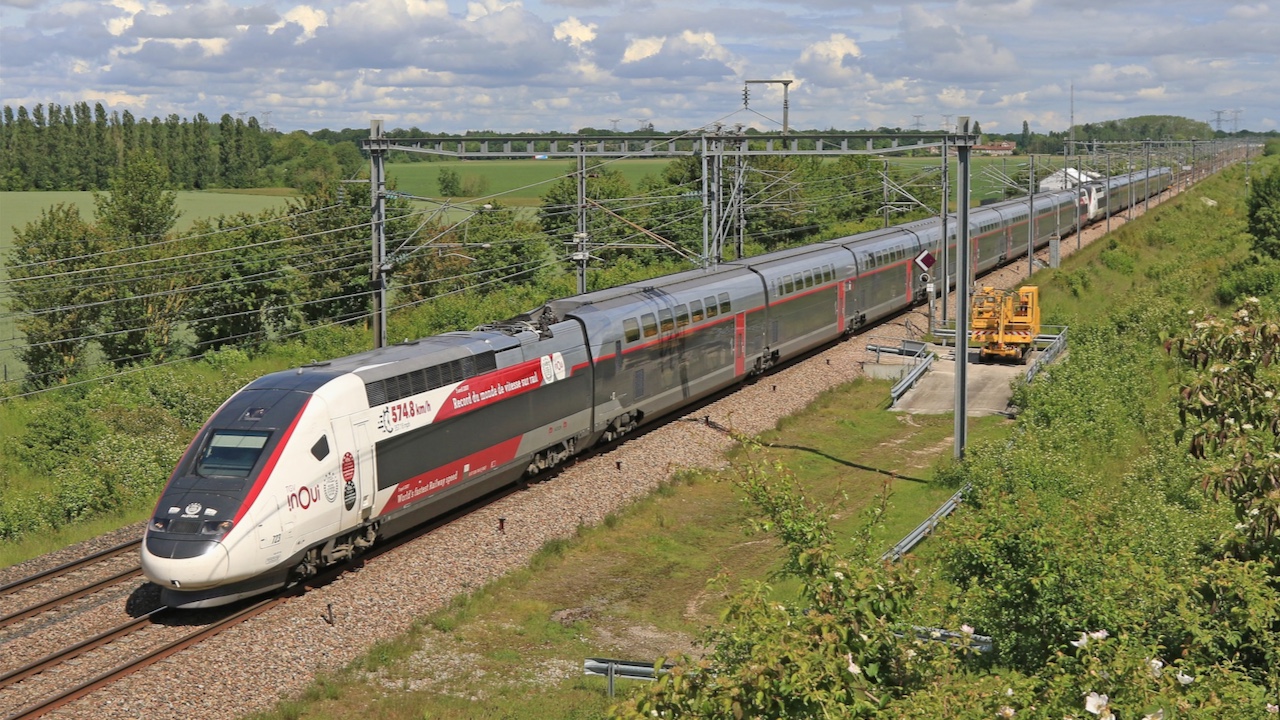
SNCF has made up a hybrid DASYE P-Duplex set numbered 723 comprising the coaches of Réseau-Duplex set No 614 and the power cars of POS No 4402, renowned for their achievement of a new world speed record of 574.8km/h during trials on 3rd April 2007. No 723 is seen here on 21st May at Chevry-Cossigny PK20 on the LGV Sud-Est. Following mid-life refurbishment at Bischheim Technicentre earlier this year, the set is now allocated to Lyon-Gerland. The power cars have been specially-painted to commemorate their dramatic exploit.
Photo: Christophe Masse.
For the record run in 2007, the two power cars were married with three specially-adapted double-deck cars in an articulated formation. The two articulation bogies in the centre of the five-car set were a powered design developed for Alstom’s AGV concept, and all the train’s traction motors had been uprated to give an astonishing total power output of 19.6MW. Weighing just 268 tonnes, the train had a power-to-weight ratio that is probably another world record. (Thanks to Murray Hughes for additional information).
Montluçon disappointment
Restoration of 120km/h running has not been achieved. Top speed will now be 100km/h, limiting journey-time improvement to no more than a few minutes and thus vitiating SNCF’s promise that Paris timings would be at least as good as in 2020. Codérail is suggesting restoration of morning, midday and evening Paris through trains to avoid the 20min time-penalty of changing at Bourges. The rolling stock situation has also changed. Though Montluçon crews are passed to drive Régiolis MUs, apparently these are to be replaced by X 72500 sets, now around 25-years-old and with poor ride and ambience.
Also criticised was the meagre service on the west-east axis from Limoges to Montluçon, the route over which Railcoop’s Bordeaux – Lyon service would have run. There are just two weekday trains, only one of which connects at Montluçon for Clermont-Ferrand. To the east, the service is better (six A/R) but no trains run through to Lyon. Codérail seeks reinstatement of twice-daily Bordeaux – Lyon trains and their designation as TET rather than TER, as well as extension of three A/R from Montluçon to Lyon.
Codérail fears for the state of the infrastructure on this part of the route. A 60km/h limit was imposed between Commentry and Lapeyrouse in June, jeopardising use by the heavy Imerys china clay trains bound for Italy. Development of lithium deposits at the Imerys Beauvoir site at Échassières depends on this line too; the ore would be carried some 16km by road for transfer to rail at Saint-Bonnet-de-Rochefort. To facilitate the project, it has been agreed that upgrading will be required between Montluçon and Gannat, but finance has not so far been forthcoming. Imerys will not proceed without a guarantee that the line will be able to accommodate ore trains.
Codérail had discussions with the préfet of Alliers in May and later presented its views to Centre-Val de Loire and AURA regional authorities. Following the failure of Railcoop, AURA is reported to be in favour of launching a Lyon – Bordeaux train via Montluçon provided the State can be persuaded to grant TET status, as with the successful Lyon – Nantes IC. This could be achieved by replanning existing services though availability of IC-quality rolling stock might be problematic.
A through train in the timings offered to Railcoop (7h 30min) would not come near the Bordeaux – Lyon driving time of 5h 37 (Google) or TGV via Paris (around 5h 10). Nevertheless, as with the Lyon – Nantes IC, a through train would provide valuable inter-regional connections and a fillip to local rail users’ morale.
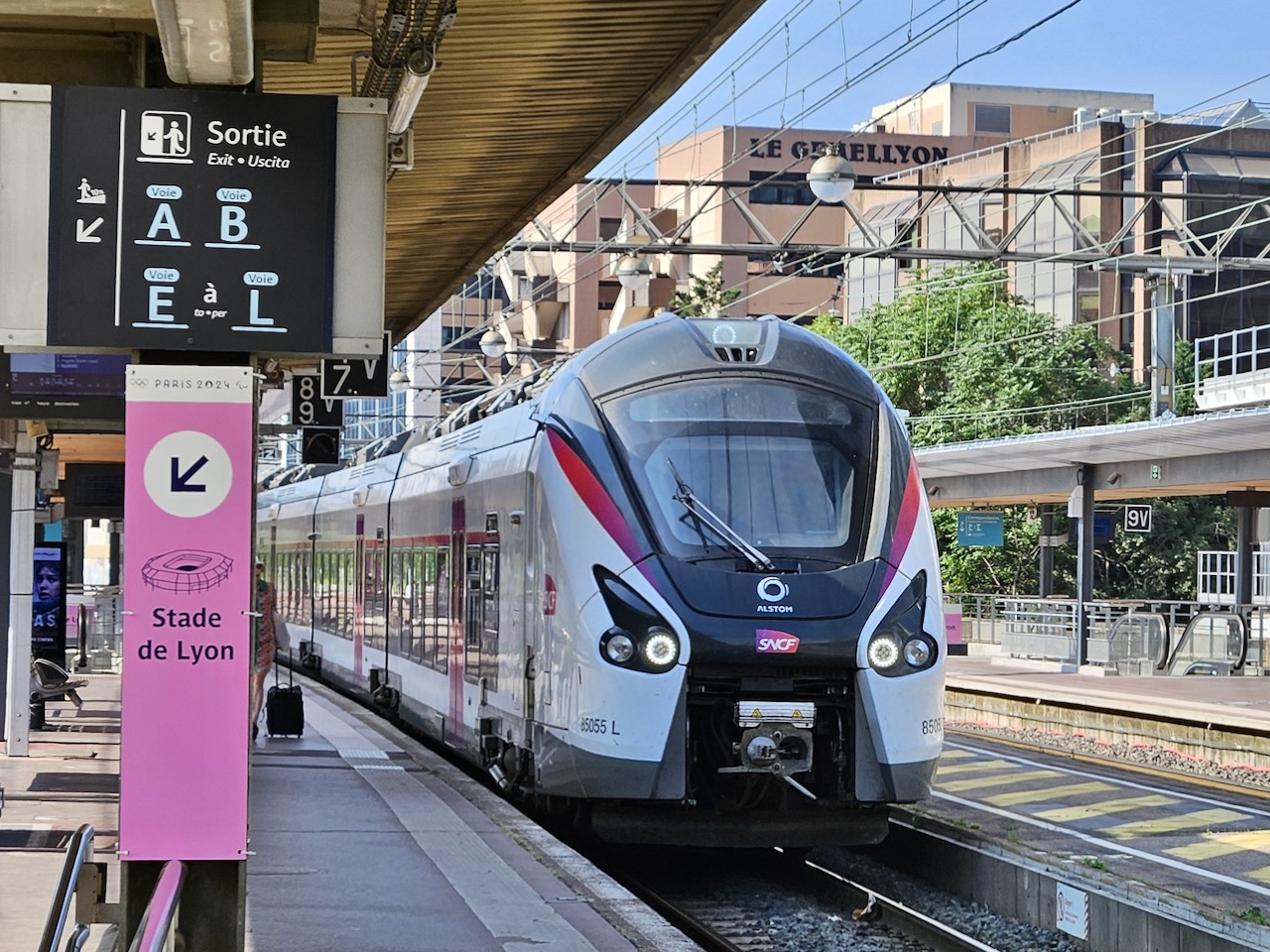
Currently, there is a once-daily Bordeaux connection out of IC 4502 the 09.21 from Lyon Perrache to Nantes, seen here on 27th June at Lyon Part-Dieu formed of Coradia Liner Set IC I28 B 85055/56. This takes 10h 41min with changes at Saint-Germain-des-Fossés (19min), Riom-Châtel-Guyon (20min), Montluçon (1h 20min) and Limoges (6min). On this day the train was heavily delayed by two signal failures, thus missing the Montluçon and Bordeaux connection at Saint-Germain-des-Fossés as well as disrupting a large number of passengers making cross-country journeys via Moulins, Nevers, Bourges, Vierzon and Saint-Pierre-des-Corps.

Since the beginning of April operation of the Dourges – Perpignan intermodal service has passed from Fret SNCF to DB Cargo as part of the 'economic discontinuance' of Fret SNCF agreed with the European Union. On the 17th May DB Cargo 186 177 passes the vineyards at Pennautier between Carcassonne and Pezens with train 50924 Perpignan – Dourges. Photo: Georges Turpin.
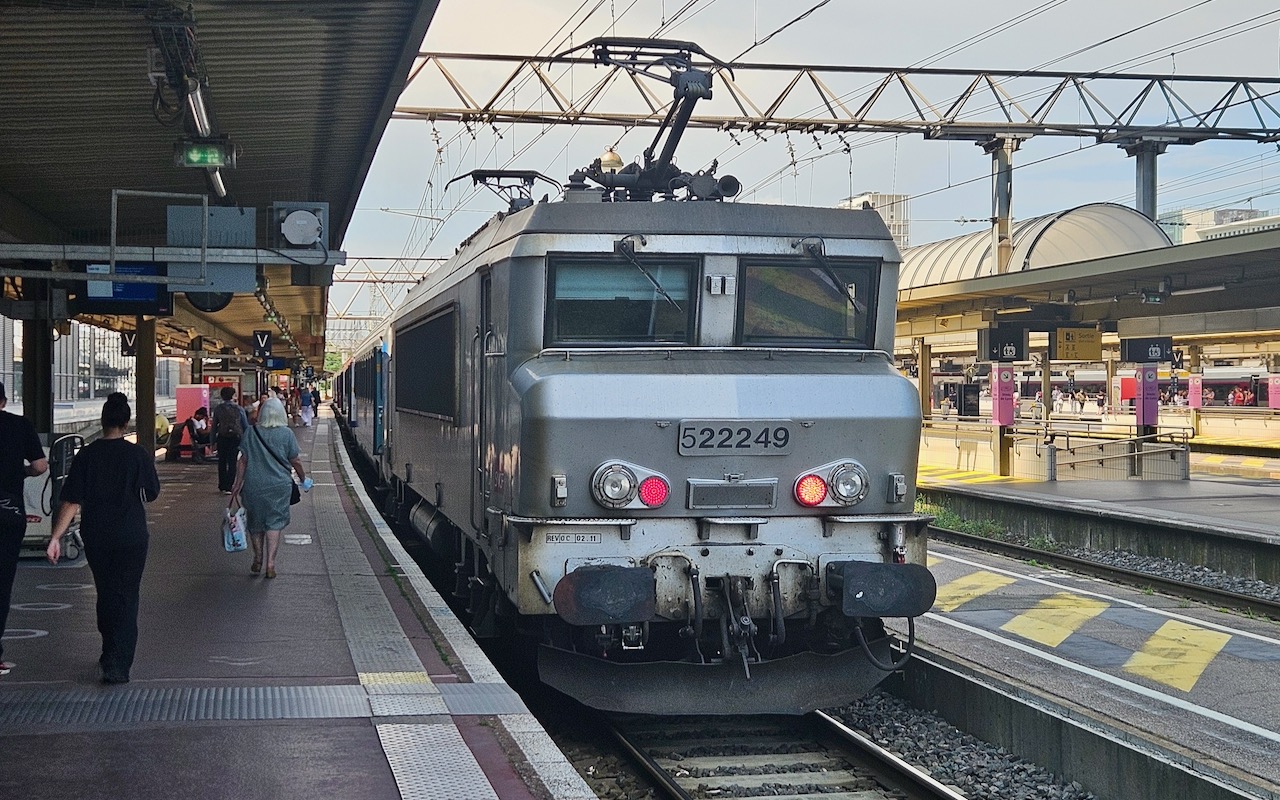
AURA is now the région that is most reliant on Corail hauled services, operated by a fleet of 33 Class BB 22200 locomotives based at Chambéry. On the 26th June BB 22249 waits to leave Lyon Part-Dieu with TER 17812 the 16.18 to Dijon. The stencil on the bufferbeam indicates it last received a works overhaul in February 2011.
AURA spending deal
The State and AURA will each invest €690 million in sustainable transport projects under the 2023-27 State/Région Contract-Plan, signed on 16th May after two years’ wrangling. The €1.38 billion outcome is an improvement on the original offer of €1 billion but falls short of the €2 billion AURA had sought to make up for years of under-investment and to prepare for the Winter Olympics in 2030.
More than half the expenditure goes to rail, amounting to about one-eighth of the funding proposed in the 10-year investment programme unveiled last October (see December News). Modernisation of TER routes will continue, absorbing €430 million. There is special emphasis on securing rural and marginal lines where infrastructure deficiencies might lead to closure, with AURA president Laurent Wauquiez saying he hoped such an eventuality would never occur again. But with some 80% of the Auvergne network falling into that category, the €170 million earmarked for emergency work is seen as inadequate.
More frequent service is planned for several lines, including Lyon Saint-Paul to Brignais and the cross-city Villefranche-sur-Saône – Lyon – Vienne route. €322 million will go towards studies and development of the planned SERM networks in AURA’s six designated urban areas: Lyon, Grenoble, Saint-Etienne, Clermont-Ferrand, Chambéry and Genève/Annemasse. Overall, 64% of the total is earmarked for rail, public transport and cycling, with just 36% for roads.
Two upgrading/capacity projects are highlighted: Aix-les-Bains – Chambéry and Lyon – Clermont-Ferrand. Funding is also provided for further work on the proposed access line to the Lyon – Turin high-speed route, along with studies for an intermodal freight hub at Lyon. Replacement of the région’s remaining loco-hauled rolling stock is not mentioned, but the new operating contract with SNCF (see May News) includes expenditure of around €1.5 billion over 10 years on acquisition of 130 Régio 2N trainsets. Alstom is currently delivering 19 Z 55900 Régio 2Ns, all six-car Courte. So far four have entered service, a further seven have been delivered but are not officially in service, and eight more are awaiting delivery.
More than half the expenditure goes to rail, amounting to about one-eighth of the funding proposed in the 10-year investment programme unveiled last October (see December News). Modernisation of TER routes will continue, absorbing €430 million. There is special emphasis on securing rural and marginal lines where infrastructure deficiencies might lead to closure, with AURA president Laurent Wauquiez saying he hoped such an eventuality would never occur again. But with some 80% of the Auvergne network falling into that category, the €170 million earmarked for emergency work is seen as inadequate.
More frequent service is planned for several lines, including Lyon Saint-Paul to Brignais and the cross-city Villefranche-sur-Saône – Lyon – Vienne route. €322 million will go towards studies and development of the planned SERM networks in AURA’s six designated urban areas: Lyon, Grenoble, Saint-Etienne, Clermont-Ferrand, Chambéry and Genève/Annemasse. Overall, 64% of the total is earmarked for rail, public transport and cycling, with just 36% for roads.
Two upgrading/capacity projects are highlighted: Aix-les-Bains – Chambéry and Lyon – Clermont-Ferrand. Funding is also provided for further work on the proposed access line to the Lyon – Turin high-speed route, along with studies for an intermodal freight hub at Lyon. Replacement of the région’s remaining loco-hauled rolling stock is not mentioned, but the new operating contract with SNCF (see May News) includes expenditure of around €1.5 billion over 10 years on acquisition of 130 Régio 2N trainsets. Alstom is currently delivering 19 Z 55900 Régio 2Ns, all six-car Courte. So far four have entered service, a further seven have been delivered but are not officially in service, and eight more are awaiting delivery.
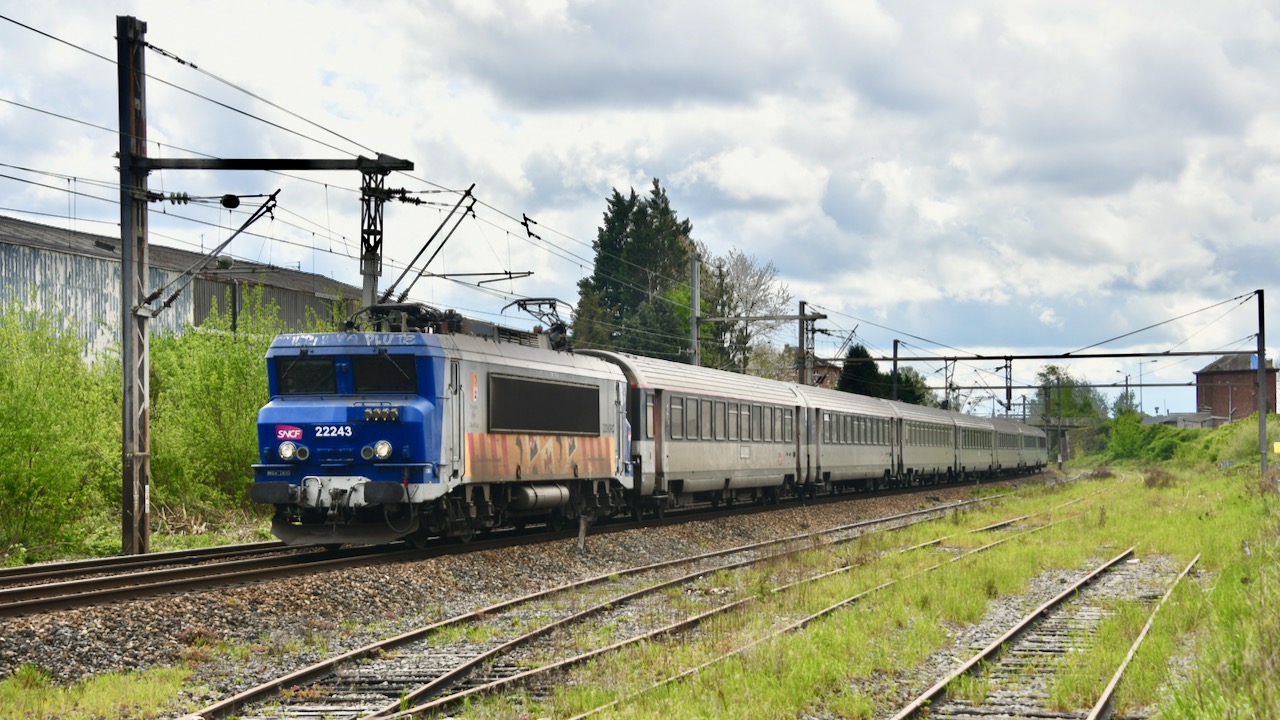
In April Hauts-de-France commissioned the last of 19 10-car XL Régio2N (Z55769/5507770 - Z55805/55807806) ‘intercity quality’ EMUs ordered from Alstom to replace BB 22000-hauled Corail stock on Paris – Amiens/Saint Quentin – Maubeuge routes. On the Maubeuge line Corail stock was scheduled to finish on the 14th June, although it was still operating on the 25th, whilst loco-hauled trains to Amiens are scheduled to cease on 5th July.
On 16th April BB 22243 normally used on push-pull duties around Lille, and still in PACA livery, was allocated to TER 16455 13.19 Paris Gare du Nord – Maubeuge, seen above passing Hauntmont. Photo: Didier Delattre.
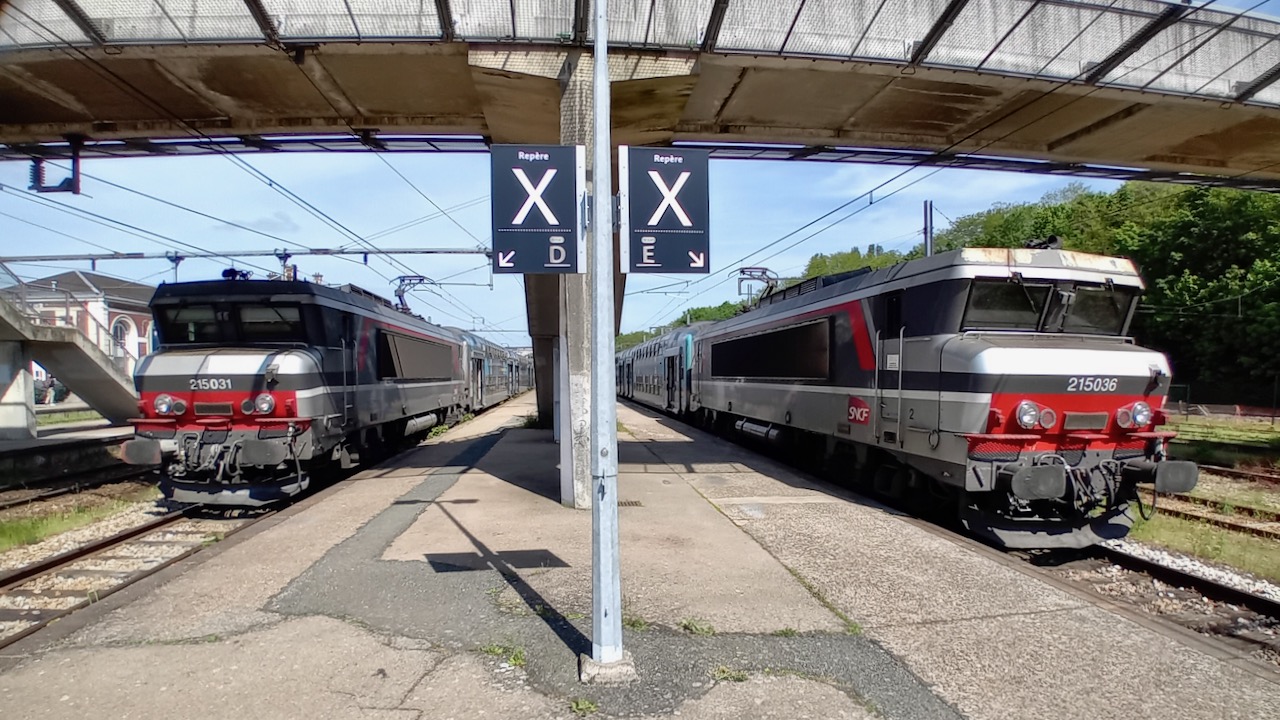
Just one of the 27 Class Z 56800 10 car Régio 2N XL units on order for Normandie TER has been delivered, with push-pull fitted BB 15000s still operating outer suburban services from Paris St Lazare. On the 10th May at Evreux BB15036 has just arrived with Train 851009 15.09 Paris St Lazare – Evreux. On the opposite platform BB 15031 waits to depart with Train 851012 16.28 Evreux – Paris St Lazare. Photo: Martin Barnsdall.
News in Brief
Châteaubriant. Tram-train T1 to Nantes celebrated its 10th anniversary in March. With daily journeys above 4,500, from December the service will be improved with extra short workings, more weekend trains and a new Friday departure from Nantes at 22.35. The town’s northern outlet to Rennes will see track improvements next year to permit 100km/h running throughout, reducing journey time to less than 1h and making it possible to add an extra daily A/R as far as Retiers. Further upgrading is planned for 2030 to equip the line for operation as part of Rennes’ SERM.
Final Primeurs. The final Perpignan – Rungis refrigerated fruit and vegetable train was scheduled to run on 28th June. The service is suspended for a year while the unloading platforms at Rungis are redeveloped into a combined fresh produce and mixed freight depot and another combined depot is built south of Rungis. The government is seeking expressions of interest to run the combined service but Fret SNCF is excluded from bidding, as this is one of the flows it must give up under the 'economic discontinuance’ agreed with the EU following the investigation into unwarranted state subsidies.
BB 27300s for sale. SNCF have put up another 18 BB 27300s for sale. 27310/326-339/342-344 are all former RER Ligne L/J locomotives. They are being auctioned by the on-line AGORA site with starting prices in the region of €1 million each.
Multimode ticket. Trials of an integrated multimodal ticket will take place later this year, linking public transport in Caen, Le Mans and Tours with TER train and bus routes in the surrounding régions of Normandie, Pays de la Loire and Centre-Val de Loire.

Rochers Noirs. Restoration of the Gisclard suspension viaduct near Soursac in Corrèze is nearing completion. The 140m-long structure, one of only five in the world still in its original state, carried the Tramways Départementaux de la Corrèze across the Luzège river until closure in 1959. It will be reopened to pedestrians in September. Photo: France Télévisions/André Abalo.
RENFE. Has established Renfe France based in Paris as a subsidiary of Renfe Proyectos Internacionales (Renfe International Projects). It groups all the company’s French activities and will position it to bid for new high-speed services and TER operating contracts as they are opened up to competition.
Akiem. On 17th May Akiem Maintenance & Service opened a depot at Ostricourt north of Douai, an investment of €22 million. The 60,000m2 site doubles the company’s maintenance capacity, allowing all work on the Prima fleet to be brought in-house as well as servicing other open access operators’ locomotives.
Briançon. Hauts-Alpes representative Joel Giraud met transport minister Patrice Vergriete on 30th May to discuss poor reliability of the Paris – Briançon night train (50% over 15min late) and its rerouting during three months’ autumn engineering work south of Dijon. One demand was for reopening the passing loop at Luc-en-Diois, between Valence and Veynes, to aid recovery during out-of-course running. Funding for capacity improvements between Veynes and Briançon in advance of the 2030 Winter Olympics (see February News) was also on the agenda.
ERT for sale. European Rail Timetable Ltd is for sale. The famous ‘red book’ containing detailed timetable information for Europe and beyond was purchased by Director/Editor John Potter from Thomas Cook in 2013.
BB 15001 preserved. At the end of May BB 15001 returned to its former depot at Strasbourg where it is to be preserved by APPFE (Association de Préservation du Patrimoine Ferroviaire de l'Est) which plans to return it to working order.
AURA security. After a year’s trial at Valence Ville, AURA région’s ‘enhanced security’ scheme is to be rolled out at Clermont-Ferrand, Lyon Perrache and several other stations. At a cost of €1 million, extra security personnel, a doubling of municipal police presence and additional cctv cameras reduced assaults, theft and anti-social behaviour at the station and in the surrounding locality.
Normandie. Will add 70 services with the December timetable change, mainly to accommodate an increase in off-peak and weekend travel. Paris – Caen –Cherbourg will have four additional weekday services, Paris – Rouen three, Paris – Le Havre two, Paris – Deauville and Paris – Granville one each, and Rouen – Dieppe two. There will also be some extra Sunday trains. Passenger-journeys increased 6% in 2023 and rose a further 6% in the first four months of 2024.
Eurostar rivals. Regulatory, security and St Pancras capacity issues will delay arrival of any new operator on the London – Paris route ‘until at least 2028’ according to an analysis by City AM. In addition to Virgin, Evolyn and Heuro, five other unnamed groups are reported to be in discussions with Getlink (see February News).
Clermont relapse. After three months of uneventful operation since the emergency plan was introduced, the Paris – Clermont-Ferrand service was in trouble again on 3rd June. BB 26007 hauling IC 5951 07.01 from Paris-Bercy failed soon after the change from 1.5kV to 25kV power at Montargis, the train coming to a stand at the next station Nogent-le-Vernisson. With the Nevers rescue loco only crewed at night, the train was delayed by 4h 30min awaiting assistance. The following 09.01 departure was diverted via Vierzon and Bourges to avoid the stricken train.
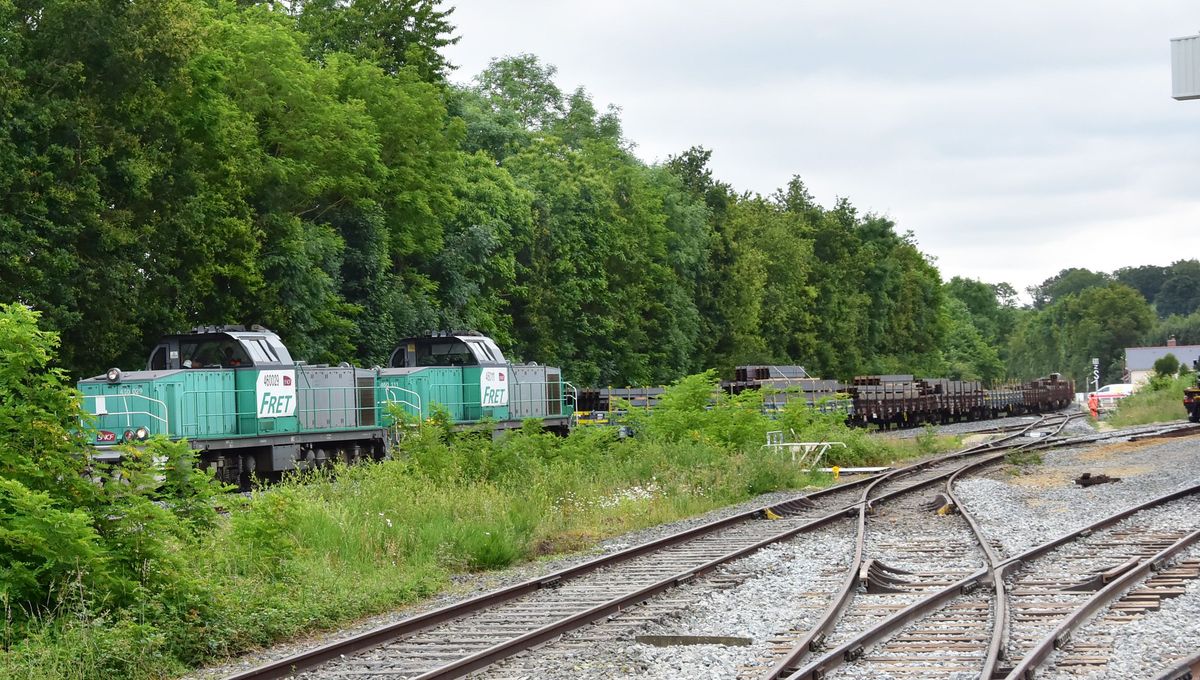
Château-Gontier. The first freight over the rehabilitated line from Sablé-sur-Sarthe (see March News) ran on 5th June, 20 wagons hauled by BB 60029 and another unidentified, carrying steel beams for the Maisonneuve distribution warehouse. Photo: Ville de Château-Gontier.
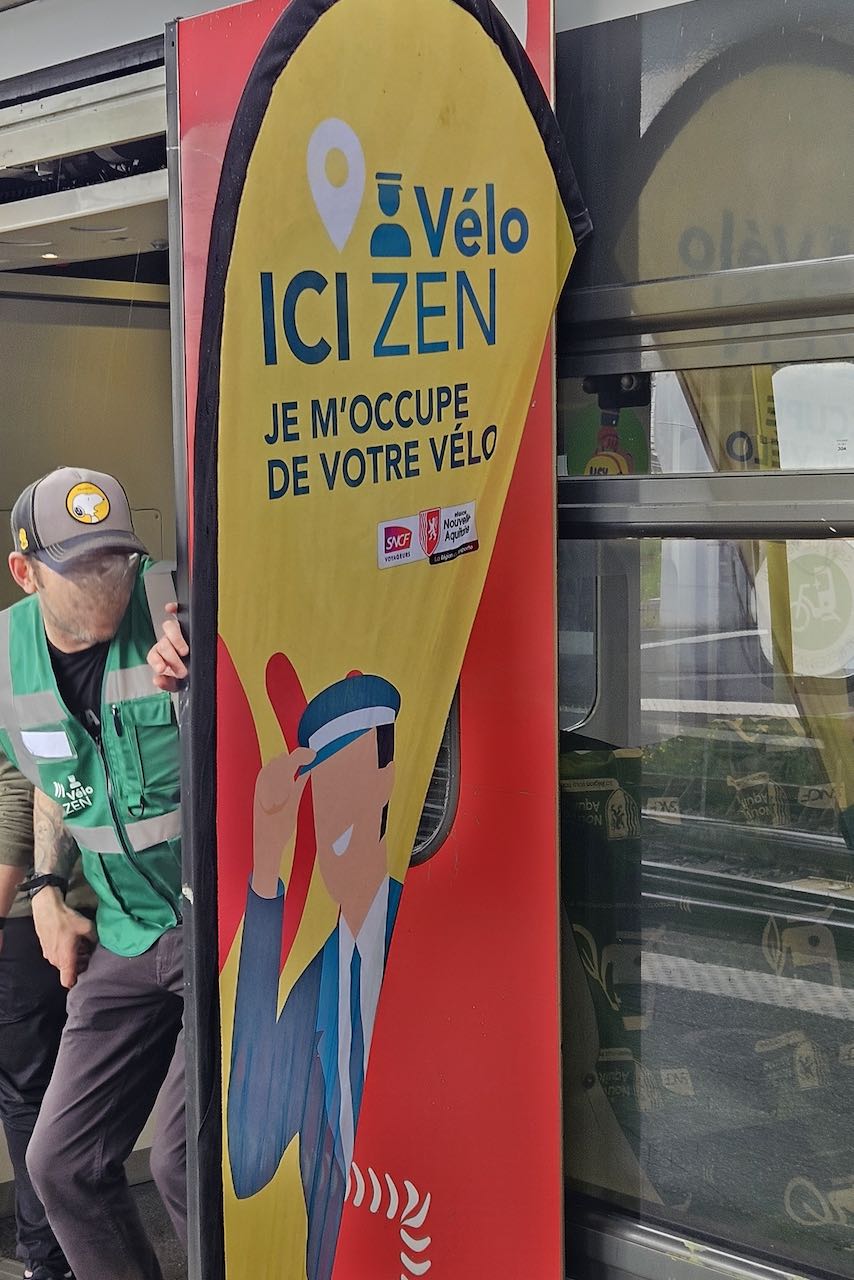
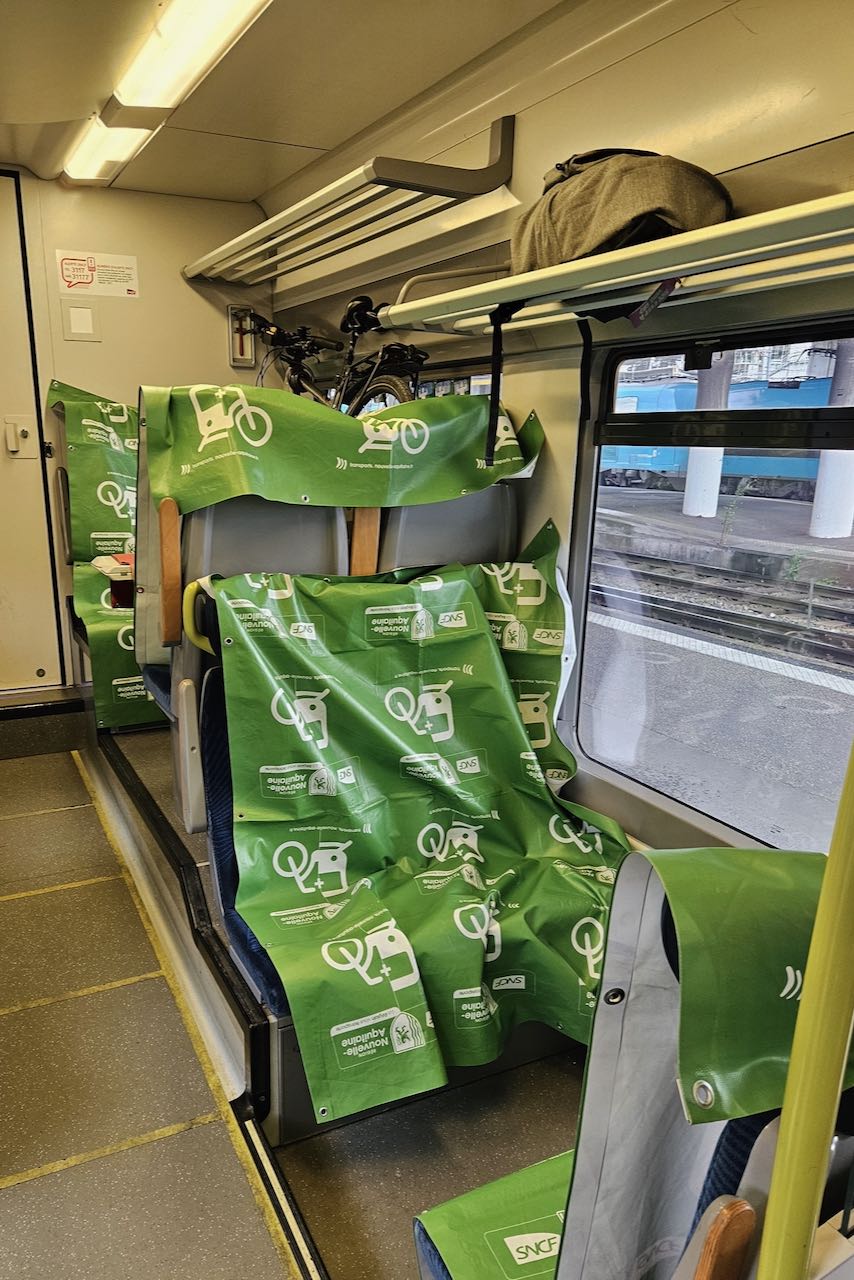
TER + velo. Saturday 1st June saw the start of Nouvelle-Aquitaine’s summer TER + velo scheme with a €3 fee for cycle space. Certain trains from Bordeaux to Hendaye, Arcachon, Le Verdon and La Rochelle have dedicated staff and a seating area reserved for cycles. One of the first was TER 866431/867230 the 15.19 Bordeaux – Hendaye/Tarbes formed of Régiolis No 51531/32 (rear) and 51529/30 (front). A saloon of the Hendaye portion was staffed and ready to receive bikes.
Infrastructure News
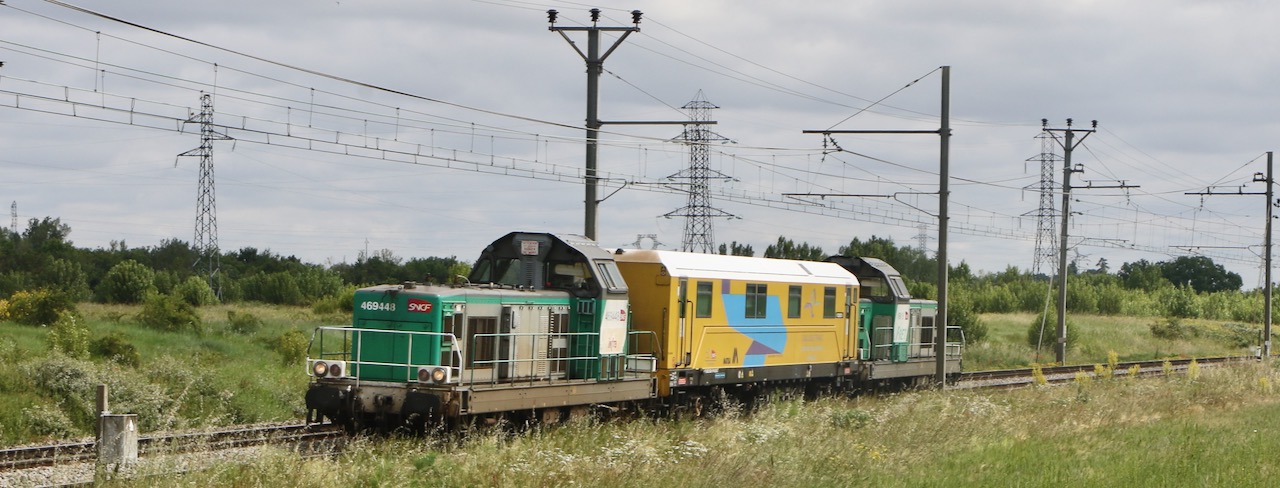
Ultrasound testing
Ultrasonic rail inspection car US 15 (99 87 9 362 502-6 FR -EURSCT) operated by Eurailscout was in operation in the Toulouse area at the beginning of June.
The inspection car can be transported at 120km/h although operates at a maximum of 60km/h when testing, and can typically cover 250km of track in a day.
Seen above on the 3rd June near Muret en route to Montréjeau-Gourdan-Polignan on the Toulouse – Bayonne line top'n'tailed by BB 69448/69454.
Photos: Georges Turpin.
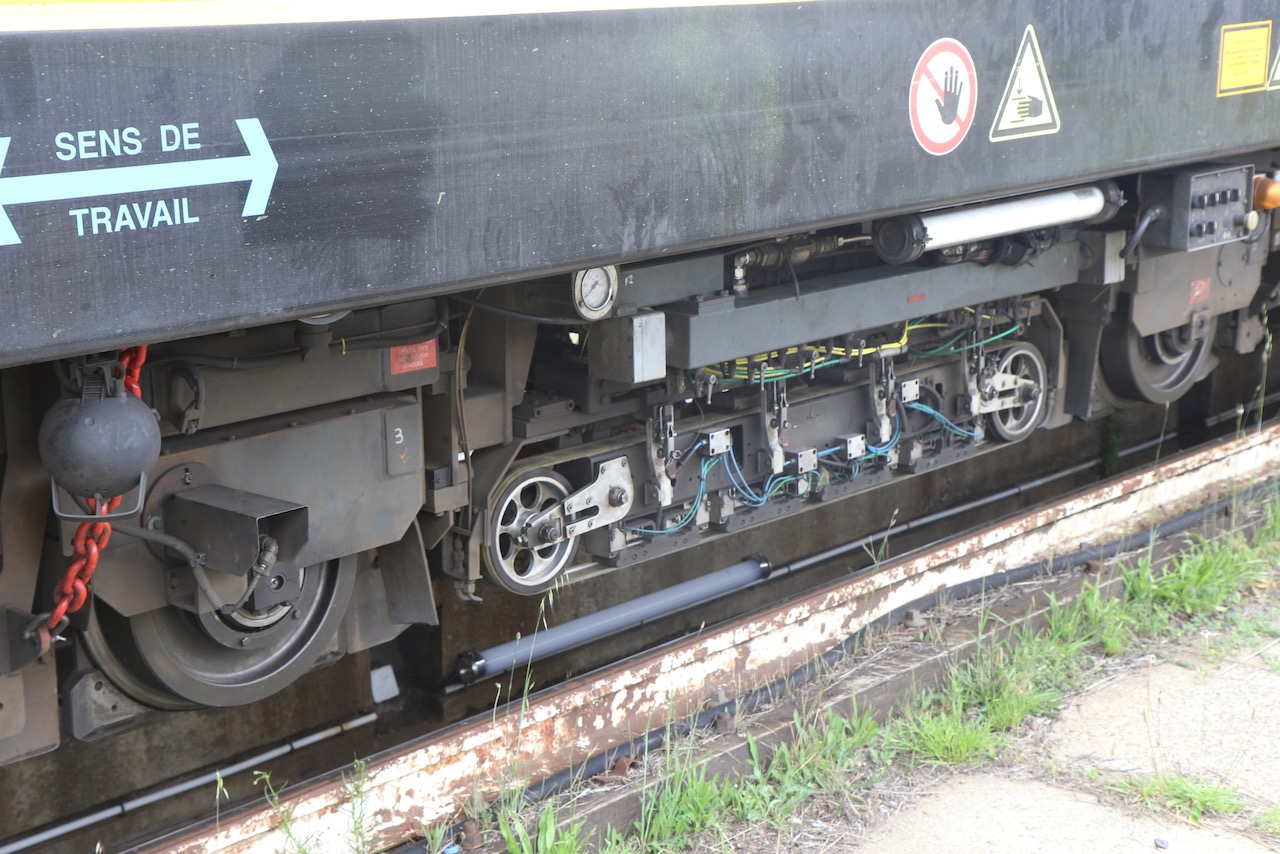
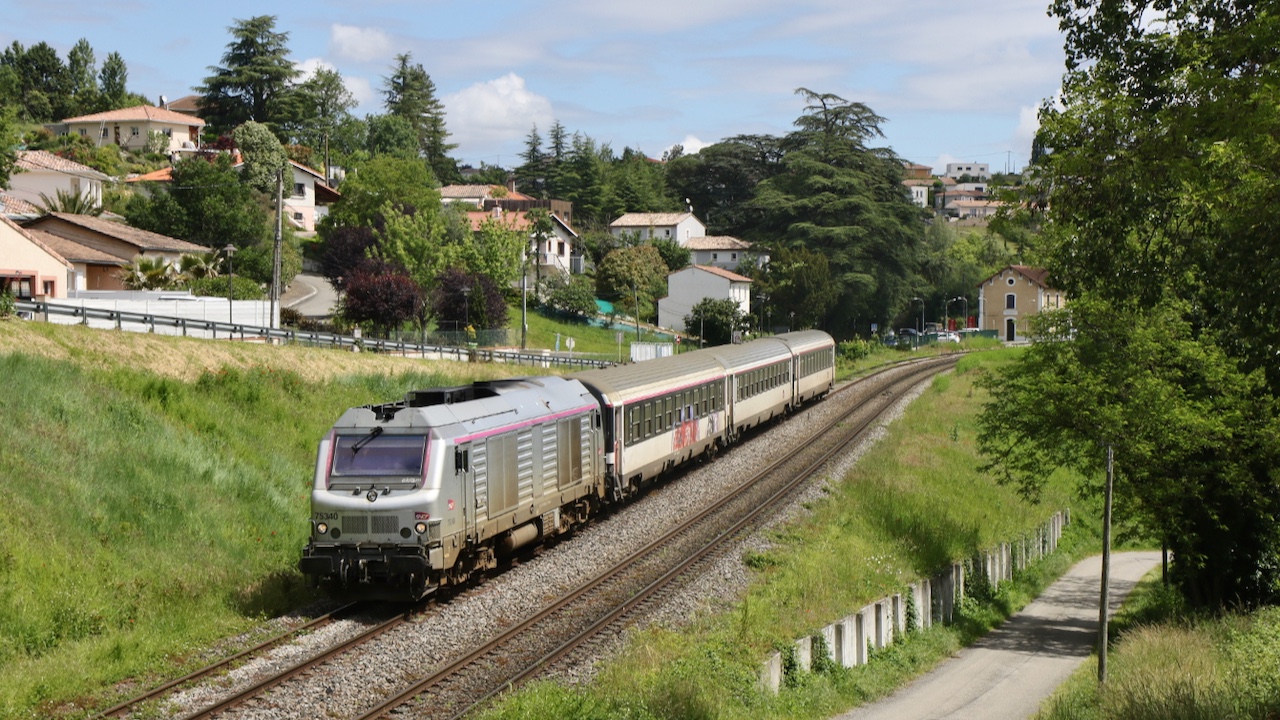
Aveyron lines suspended
The Brive – Rodez line is closed between Capdenac and Rodez until the 4th August, following a landslide at Nuces on 1st May. Repairs costing €2 million need to be undertaken. Buses replace daytime trains and also the night service which was advertised as an Autocar departing Paris Austerlitz 21.30 and Rodez 22.50 at a fare of €21. Rail connection was also available with ICN 3750/1 at Toulouse, departing Rodez at 18.44.
Coaches of the night train were trapped at Rodez until removed on 24th May by BB 75300 No 75340 seen here at Montastruc-la-Conseillère having passed a TER heading for Mazamet. Train 512151 ran as ECS from Rodez to Toulouse, bringing the rare sight of Corail stock to this line. Photo: Georges Turpin.
Coaches of the night train were trapped at Rodez until removed on 24th May by BB 75300 No 75340 seen here at Montastruc-la-Conseillère having passed a TER heading for Mazamet. Train 512151 ran as ECS from Rodez to Toulouse, bringing the rare sight of Corail stock to this line. Photo: Georges Turpin.
Nearby on the Tessonnières – Capdenac line, infrastructure work was completed on 28th June and trains were scheduled to resume from 5th July. The line was closed for three months for renovation and strengthening of bridges, tunnels, cuttings and embankments at 21 locations, including major work on the 1.5km Souel tunnel where pressure-grouting was used to stabilise large areas of old brickwork damaged by water ingress.
Carried out as part of the Plan Rail Occitanie upgrading programme, the €25 million cost was financed by Occitanie (66.5%), the State (25%) and SNCF Réseau (8.5%).
Photo: La Dépêche du Midi/MPV.
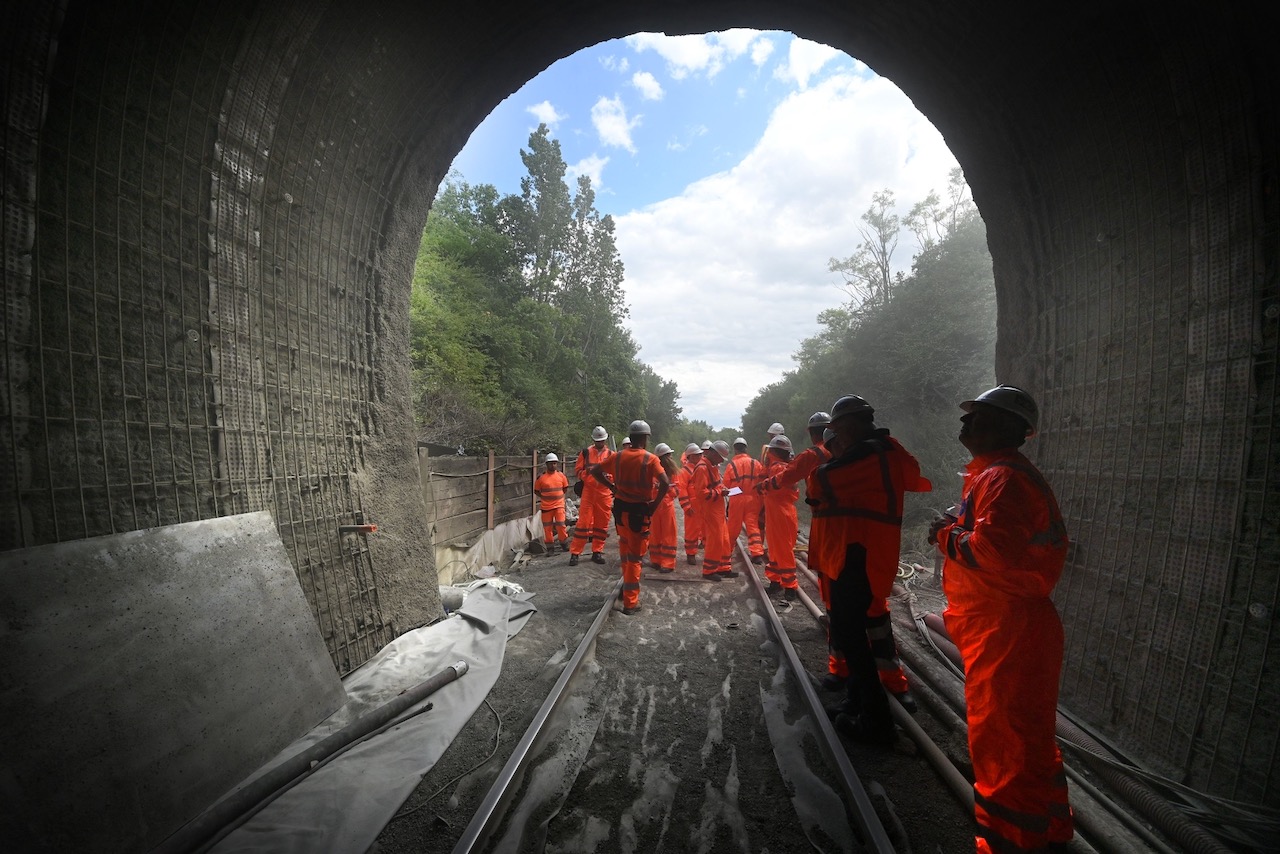
Périgueux – Agen. Following Nouvelle-Aquitaine’s refusal to include upgrading of the line in the next State/Région Contract-Plan (see March News), maires of communes along the route threatened to boycott the European elections on 9th June. The région quickly changed course, and on 20th June announced a grant of €37 million for remedial work to ensure the line remains open until full-scale regeneration starts in 2028.
Objat. Also in Nouvelle-Aquitaine, locals are waiting to see if reopening between Objat and Saint-Yrieix (41km) will be included in the new Contract-Plan. The central section of the secondary route between Limoges and Brive was closed in 2018 due to the poor state of the infrastructure. Despite recent expenditure of €22.5 million on the northern part, no funding is available for rehabilitating the closed portion to restore through trains.
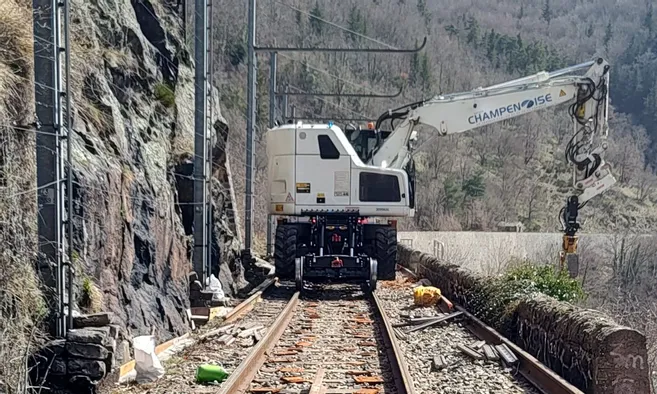
Monistrol d’Allier. Work to repair last December’s landslip was finished and the Cévenol line reopened on 24th May. Some 80m of trackbed has been rebuilt, new drainage systems installed and signalling/telecoms replaced; additional rockfall protection has also been provided. Annual remedial work between Langeac and Langogne, started in February, was also completed after a slight over-run led to morning trains being cancelled for several days. Photo: L’éveil de la Haute-Loire/DR.
Calvi. The main station was closed during June for track renewal, the eight daily trains departing from Calvi Talle (Lido) some 10min walk from the centre. This work completes upgrade of the line following commissioning of Commande Centralisée de Voie Unique between Calvi and Île-Rousse (21km) at the end of last year.
Rodez – Millau. Aveyron Senator Alain Marc has upset Occitanie officials by referring to the proposed reopening of Rodez – Sévérac-le-Château – (Millau) as ‘economic folly’. He suggested a hydrogen-powered bus service would provide superior benefits at much lower cost. Reopening of the 45km line, one of Occitanie’s priority routes, has been costed at up to €130 million. The purpose would be to provide a Millau – Toulouse service, though the journey would take at least 1h longer than the driving time of 2h 28 (Google). The line was carrying fewer than 100 passengers a day before closure in 2017. Occitanie said it remained committed to reopening by 2030.
Arve Valley. Upgrading of the single line between La Roche-sur-Foron and Saint-Gervais-les-Bains (47km), approved by SNCF Réseau last year, will not now start until April 2028. Following the impact assessment carried out two years ago, there will be further public consultation during 2025. The €178 million project includes resignalling, augmentation of the power supply and weather-proofing to increase capacity from 38 to 52 trains daily. The line would be closed for 18 months whilst the work is carried out. On 14th June, SNCF Réseau and Haute-Savoie département signed an agreement for abolition of 10 of the line’s 39 level crossings, with the first four to be replaced by 2028 at a cost of €110 million.
Canfranc. The Spanish ministry of transport is seeking tenders for a study of possible routes for freight to access the Mediterranean Corridor should the Pau – Canfranc line be reopened as projected, including a line avoiding Zaragoza. The study is part of the broader initiative funded by the Connecting Europe Facility (CEF) for reopening Pau – Canfranc – (Zaragoza) as a freight artery.
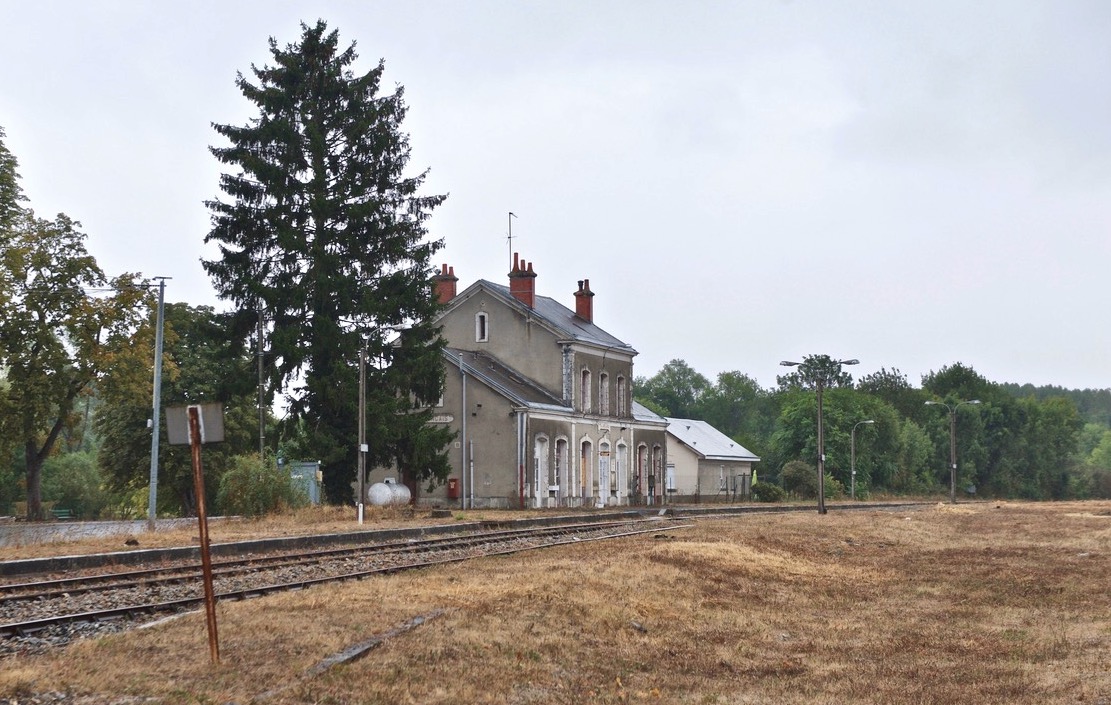
Buzançais. Emergency engineering work has been completed between Châteauroux and Buzançais, including spot replacement of 2,500 sleepers and renovation of level crossings at a cost of €2.1 million. The 26km stub of the Tours – Châteauroux line, closed to passengers beyond Loches in 1977, provides access to Ferval’s 7km regauged portion of the Blanc-Argent metre-gauge railway which serves grain silos at Argy.
Livernan. Work to enlarge this tunnel (1,467m) south of Angoulême is due for completion in November after a pause during the summer. Under the scheme to provide clearance for Brittany Ferries semi-trailers on the Autoroute Ferroviaire sur l’axe Atlantique between Calais and Bayonne, 346m of the tunnel lining is being rebuilt to 4m height. In the final phase, similar work will be carried out on Bâchées (427m), Plans (1,120m) and Angoulême (779m) tunnels.
Rennes. Closed since 3rd January due to a bogie fault (see February News), automated Line B resumed operation at midday on 20th June. Trains ran all night on the 21/22nd for crowds attending the city’s festival of music.

Mont-de-Marsan visitors
AGC BiBi MU (diesel, 1.5kV DC/25kV AC) No 82525/26 was an unusual sight at Mont-de-Marsan (below) on a gloomy 30th May. The L45 service from Bordeaux is normally operated by Class 81500 bimode units (diesel, 1.5kV DC), of which No 81671/72 is seen beneath the marquise waiting departure with TER 866606 10.48 to Bordeaux.
The following day, DB Cargo France Class 66 No 66217 arrived from Hourcade yard (Bordeaux) at 10.20 with tank wagons carrying aviation fuel from La Rochelle for the Mont-de-Marsan airbase. The fuel depot, 4km east of the station on the closed line towards Marmande, has a trailing connection and no runround loop so a second loco is required to manoeuvre the tanks in and out of the siding. Along with Vossloh G 1000 BB No 1011, the Class 66 was parked up over the weekend awaiting its next duty.
On 6th June (above), the two locos double-headed 21 empty tank wagons out of the yard at 14.20 with the return working, Train 466760; No 66217 somewhat overshadowed by the larger-profile rolling stock. DB Cargo France took over this service from ETMF last year; the contract covers deliveries to several airbases. The 66s retain their English Welsh & Scottish livery more than 15 years after transfer to France and are still marked for Euro Cargo Rail. DB Cargo France does not intend repainting them.
Another aircraft fuel working, in May 2021, saw a pair of Vossloh G 2000 BBs with No 1755 leading on a westbound tank train between Narbonne and Carcassonne. Photos: Chris Bushell and Georges Turpin.

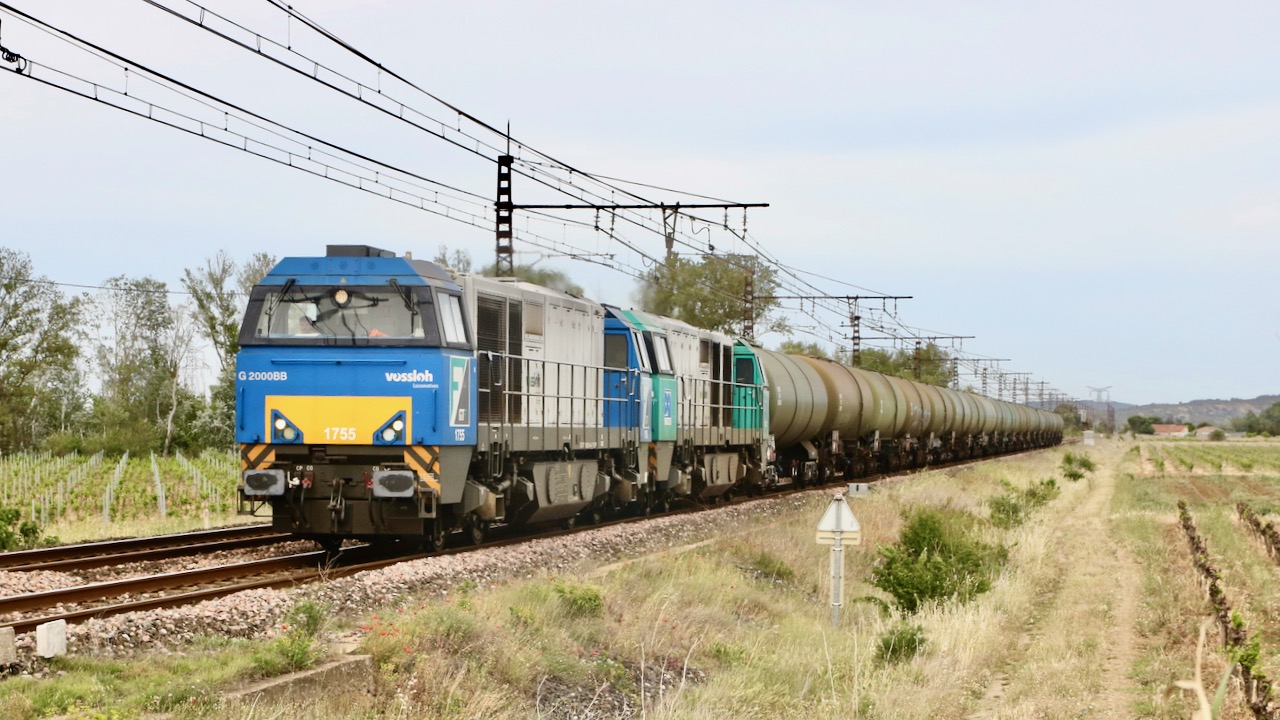
Preservation
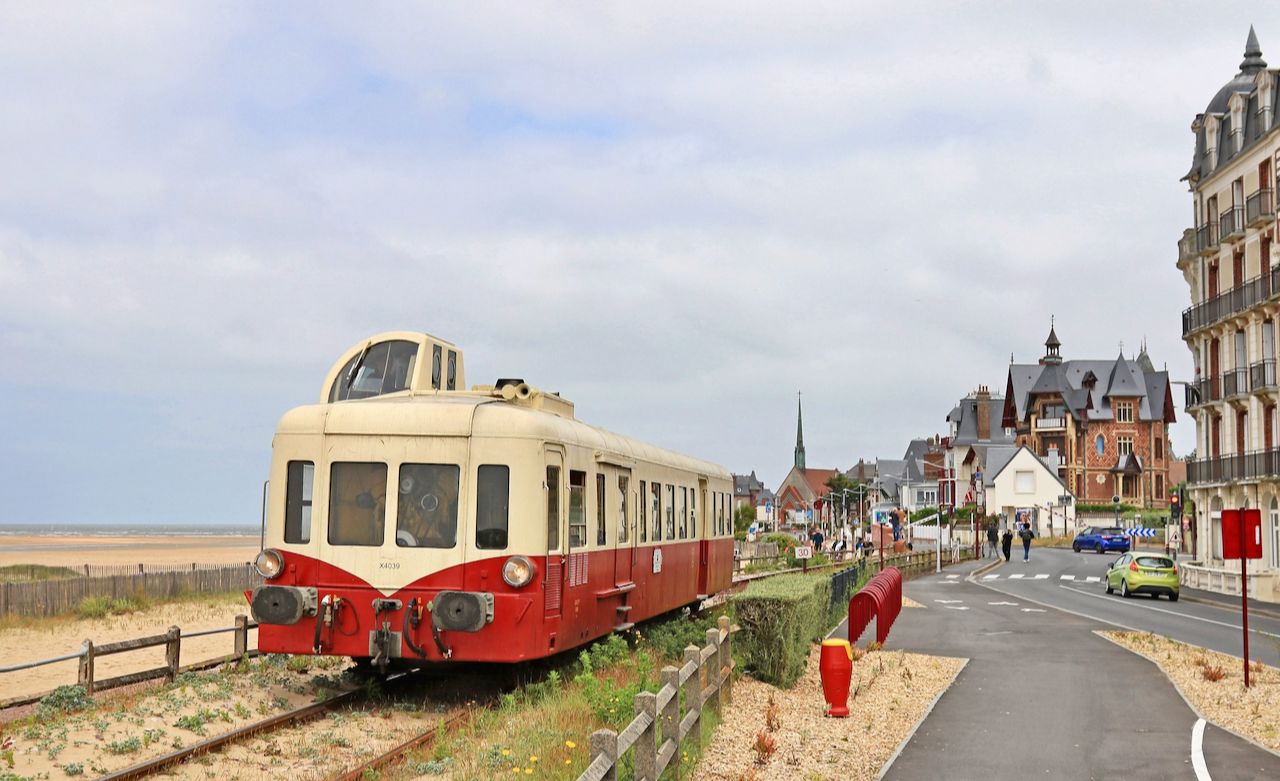
Over the first weekend in June Picasso X4039 undertook a tour of Normandie including the Deauville to Dives-Cabourg branch. It is seen running beside the beach as it leaves Houlgate on the 2nd June. Photo: Christophe Masse.
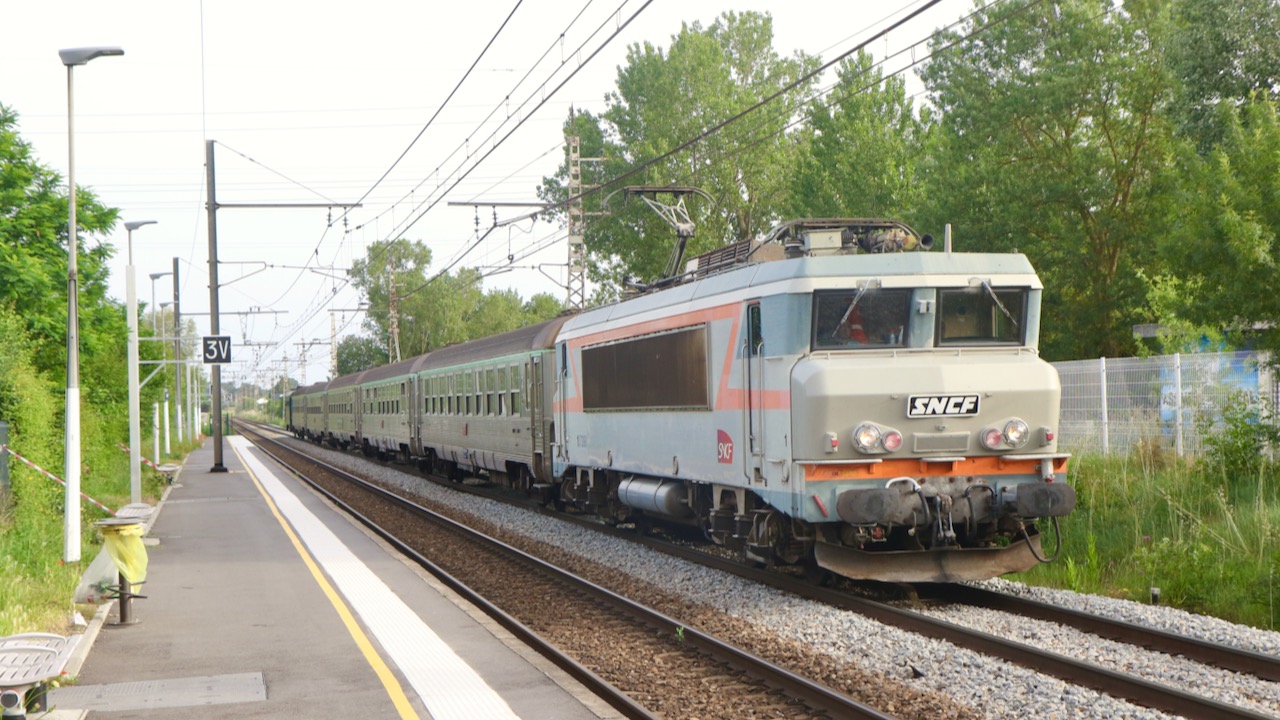
Above. On Saturday 8th June Le Train historique de Toulouse ran an excursion from Toulouse to Cerbère providing the opportunity to visit Le Train Rouge and the Côte Vermeille resorts. Seen above passing through Labège-Innopole with BB 7398 running solo, and sporting a newly painted nose-cone, but yet to receive an orange stripe. Photo: Georges Turpin.
Below. A week later on the 15th June L’AAATV-CVL ran an excursion from Les Aubrais to Reims headed by A1A A1A 68540 seen above passing through Chézy-sur-Marne. Photo: Jocelyne Bourneuf.
Both trains also conveyed steam heating vans indicating the steam heritage of both associations. Although both have excursion programmes for the summer only AAATV-CVL is currently planned to operate their 141 Rs, with 141 R 840 scheduled to run from Les Aubrais to Cosne-sur-Loire on the 20th July and to Tours on the 24th August, where the train will be diesel hauled to Saumur and Thouars.
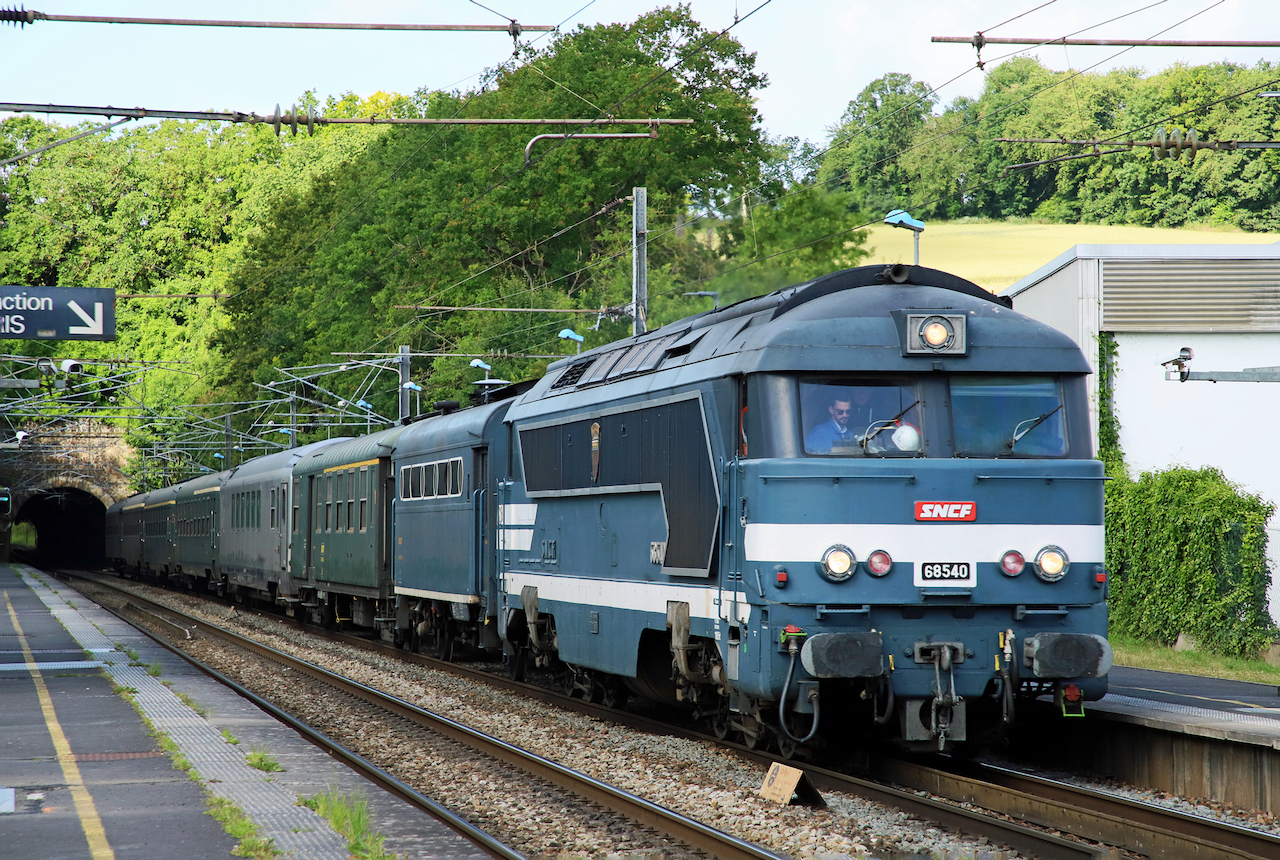
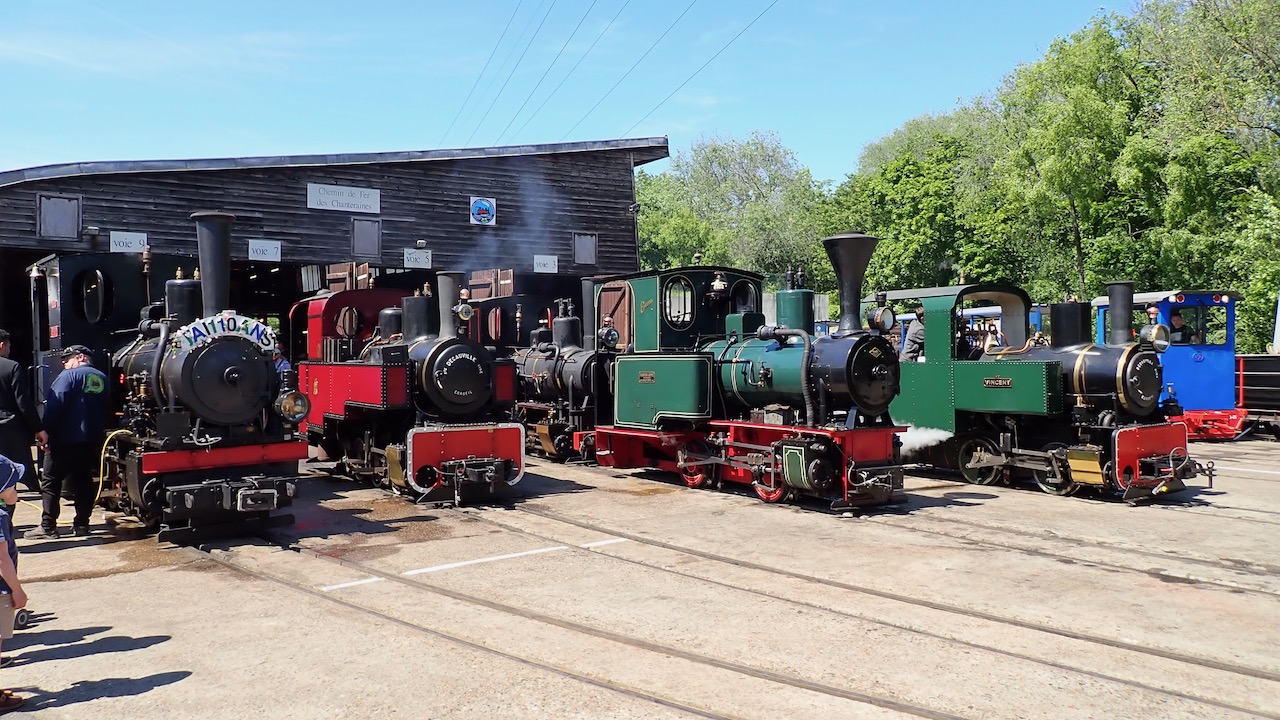
Chemin de fer des Chanteraines re-opens after €4 million investment
Official inauguration of the renovated Chemin de fer des Chanteraines (CFC) at Villeneuve-la-Garenne in the northern Paris suburbs took place on 1st June. The two-year modernisation of the infrastructure of the 600mm gauge réseau cost €4.12 million and was funded by its owner, Hauts-de-Seine départment. The railway is operated by Association du Chemin de fer des Chanteraines under a 10-year agreement. The inauguration followed the Association’s 40th anniversary event that took place over the weekend of 9/12th May.
The scope of the renovation covered the replacement of 5.5km of track and ballast, creation of a seventh station at Mariniers and the acquisition of two electric locomotives to reduce reliance on diesel shunters. The CFC carries over 20,000 passengers a year and has a fleet of 26 locomotives including six steam, and a large selection of rolling stock. It is operated by 73 volunteers of whom a third are under 30 years old. All members are taught to drive once they reach the legal age limit. Details athttps://www.cfchanteraines.fr/sitewp/
Above. The line-up of CFC steam locos at Villeneuve-la-Garenne depot during the 40th anniversary celebrations on 11th May.
Photo: Didier Delattre.
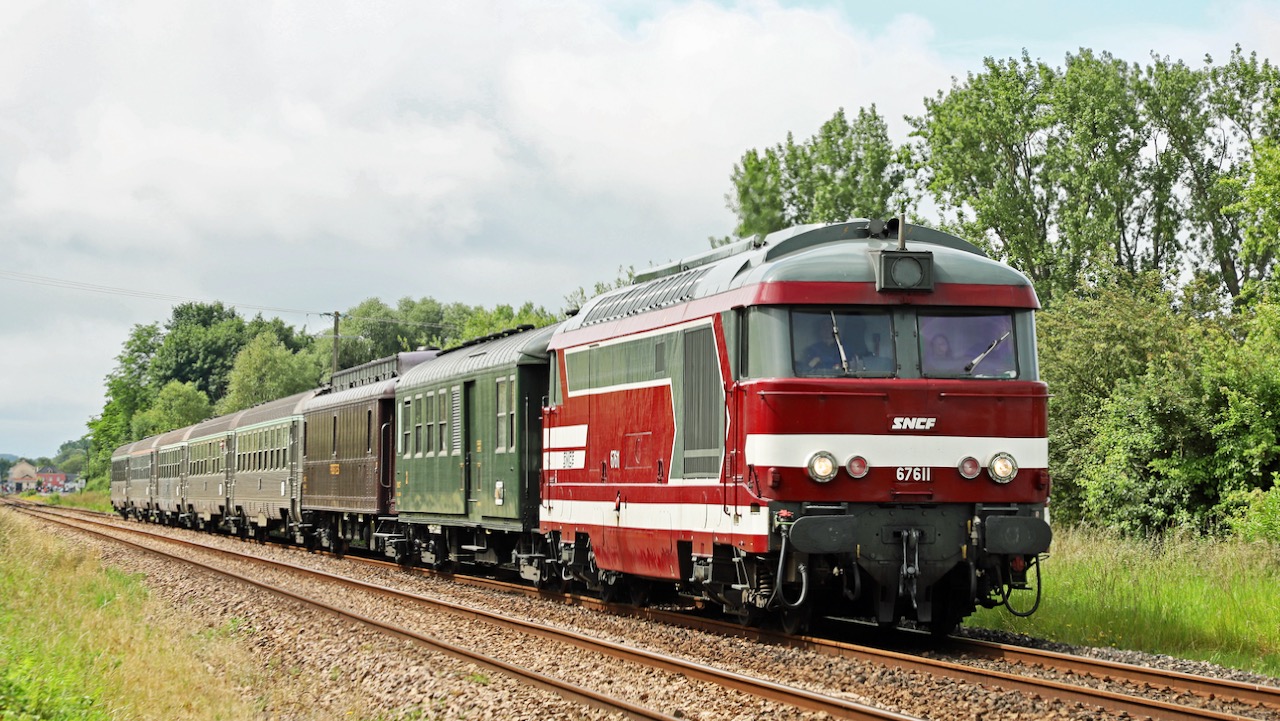
On the 22nd June, MFPN operated their 'Flèche d'Argent' excursion from Paris to Boulogne. With their BB 68400 unavailable traction was provided by CMR BB 67611 returning the class to a line that they dominated from the mid 1970s until 2019. Above BB 67611 is seen pulling away from noyelles after dropping off passengers for the CFBS. Photo: Jocelyne Bourneuf.
Urban rail
RER Line C plans
More detail is available on Île-de-France Mobilités’ proposals for a €4 billion modernisation of RER Line C (mentioned in April News), one of the busiest and most operationally challenging in Paris. The 176km route has six branches serving 84 stations and carries up to 540,000 passengers daily on 540 trains. Because some sections are shared with TGV, IC, TER and local trains, reliability is often compromised (punctuality is below 90%), while the 150 Z2N double-deck EMUs dating from the mid-1980s are beginning to show their age.
A key aim will be to reduce the impact of delays and incidents by ensuring trains can be more easily turned short of destination or rerouted to regulate the service. Several options are being studied aimed at simplifying the service pattern, and how best to serve the southern branches to Dourdan La Forêt and Saint-Martin d’Étampes. Track remodelling and additional loops and crossovers are planned at several locations including Avenue-Henri-Martin, while Brétigny-sur-Orge station is to be rebuilt to allow more services to run in the four-track section between there and Juvisy
Opposite. On RER Line C at Saint-Michel on 31st May Train SORO 09.18 to Saint-Quintin-en-Yvelines is headed by Z2N set 50T.

The Z2Ns are to be replaced by new Z2N NG trainsets from 2033 onwards, once upgrading of the infrastructure and power supply has been completed. A fleet of 160 trains is to be procured. New depots will be built to service them at Brétigny-sur-Orge and at Gennevilliers, while the existing Line C works at Les Ardoines will be renovated and expanded. Earlier replacement of some Z2Ns with Régio 2N stock is under consideration.
Competition. RATP Cap Île-de-France has been selected to operate the T12 and T13 tram-train routes when current contracts end next year. This is Lot 2 of the lines being opened to competition.
GPE. A consortium led by Bouygues Travaux Publics has won the penultimate GPE contract, for design-and-build of Line 15 East from Saint-Denis-Pleyel to Drancy-Bobigny comprising 8km of tunnel and four stations at a cost of €1.09 billion. Grimshaw Architects Paris will design the Line 15 underground station at La Défense, opening in 2031. On 18th June, ÎdF Mobilités confirmed that Keolis will be the operator of GPE Line 18 linking Aéroport d’Orly with Versailles Chantiers, the first section of which opens in 2026.
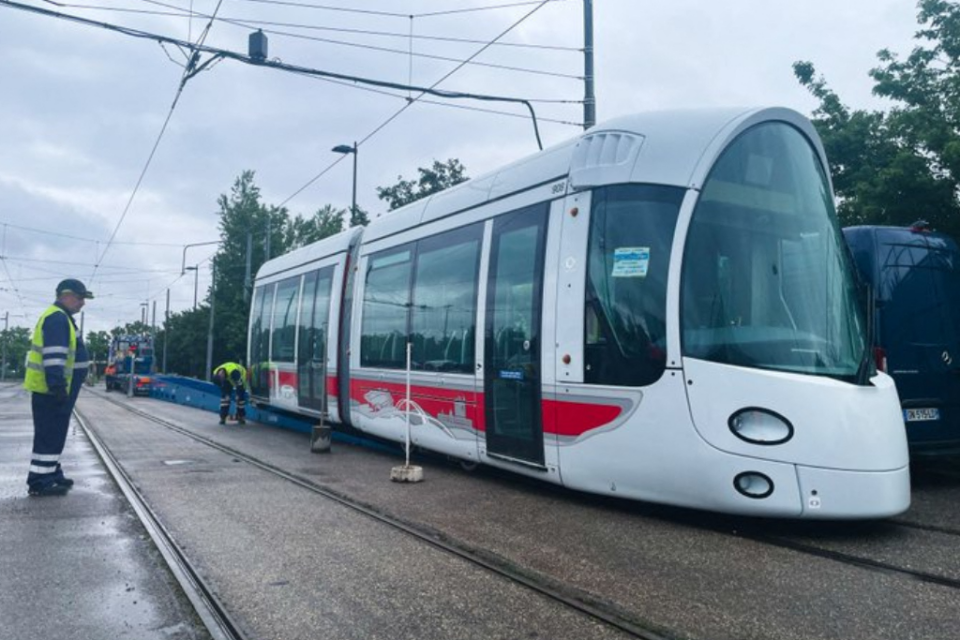

Lyon. The first of TCL’s 43m-long tramcars was delivered on 16th May. Alstom is supplying 35 Citadis 402 cars at a cost of €115 million. They will operate initially on T3 and 4, with later deliveries destined to augment capacity on T1 and 2 once platforms are lengthened to accommodate them. On 4th June, one of the current fleet was unveiled in designs by local artist Jeanne Saboureault representing various Olympic sports, diversity and the rainbow colours of LGBT+ for Pride month.
The Métropole’s Découverte mobilité scheme (see April News) closed at the end of May with 9,660 residents having taken up the offer of three months’ free travel to try public transport, half of whom used cars as their main mode of transport. Photos: Sytral.
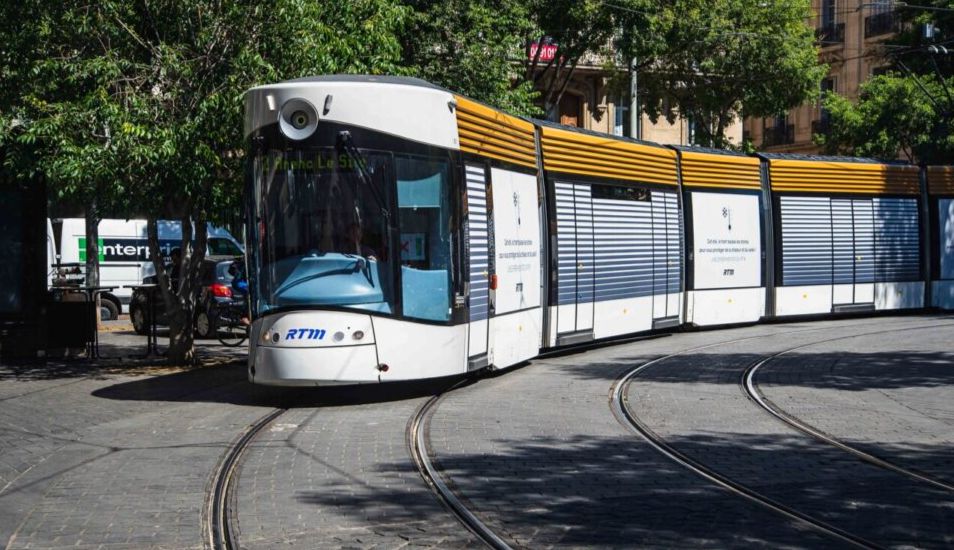
Marseille. In an attempt to reduce summer heat inside trams, RTM is trying out micro-perforated adhesive vinyl window coverings on 10 cars. If successful, the vinyls will be applied to metro cars next year.
See photo opposite.
Something for the modellers?
Occitanie TER Régio 2N 434Cm (Z 56367/5607368) is seen descending Capvern incline east of Tarbes on 21st May with the front two vehicles heavily graffitied. It was paired with set 435Cm (Z 56369/5607370) in pristine condition.
Some UK model businesses are now offering graffiti as part of their painting and weathering service. In seeking to achieve realism, would you want to replicate this degree of vandalism on an expensive model?
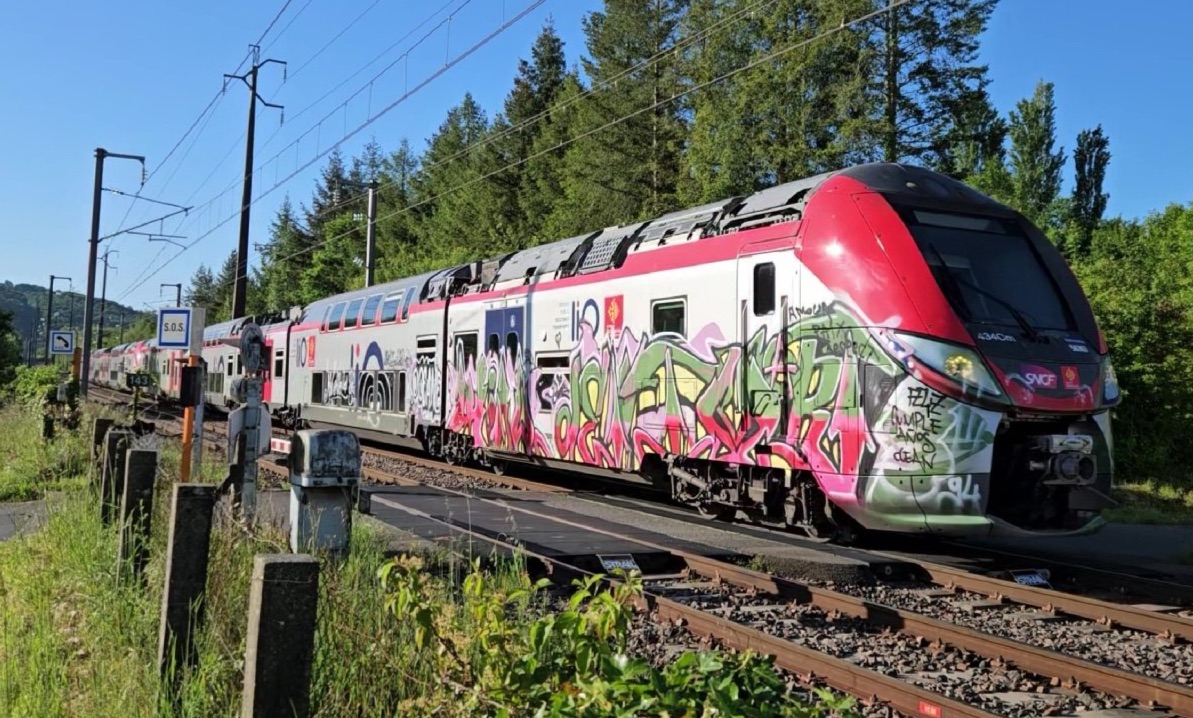
Additions to FRS Photographic Archive during May/June 2024
To Photographic section
- A new gallery of images made available by our new member Jean Filliette
- Some 90 images have been added to the David Thirlwall gallery in Folder 1
- Nil
Additions to the FRS public folder during May/June 2024
- An updated photo index for the David Thirlwall gallery has been placed in the public folder

© Peter Lovell & Chris Bushell. The French Railways Society 2024. With thanks to Georges Turpin, Didier Delattre, Christophe Masse, Jocelyne Bourneuf and Martin Barnsdall.
